Information System
VerifiedAdded on 2022/11/09
|28
|7826
|277
AI Summary
This report discusses 5 different aspects of information system including challenges and opportunities of machine learning, strategic position of Amazon with two strategic planning tools, advantages and disadvantages of migrating information systems to the cloud, and more.
Contribute Materials
Your contribution can guide someone’s learning journey. Share your
documents today.

Running head: INFORMATION SYSTEM
Information System
Name of the Student
Name of the University
Author’s Note:
Information System
Name of the Student
Name of the University
Author’s Note:
Secure Best Marks with AI Grader
Need help grading? Try our AI Grader for instant feedback on your assignments.
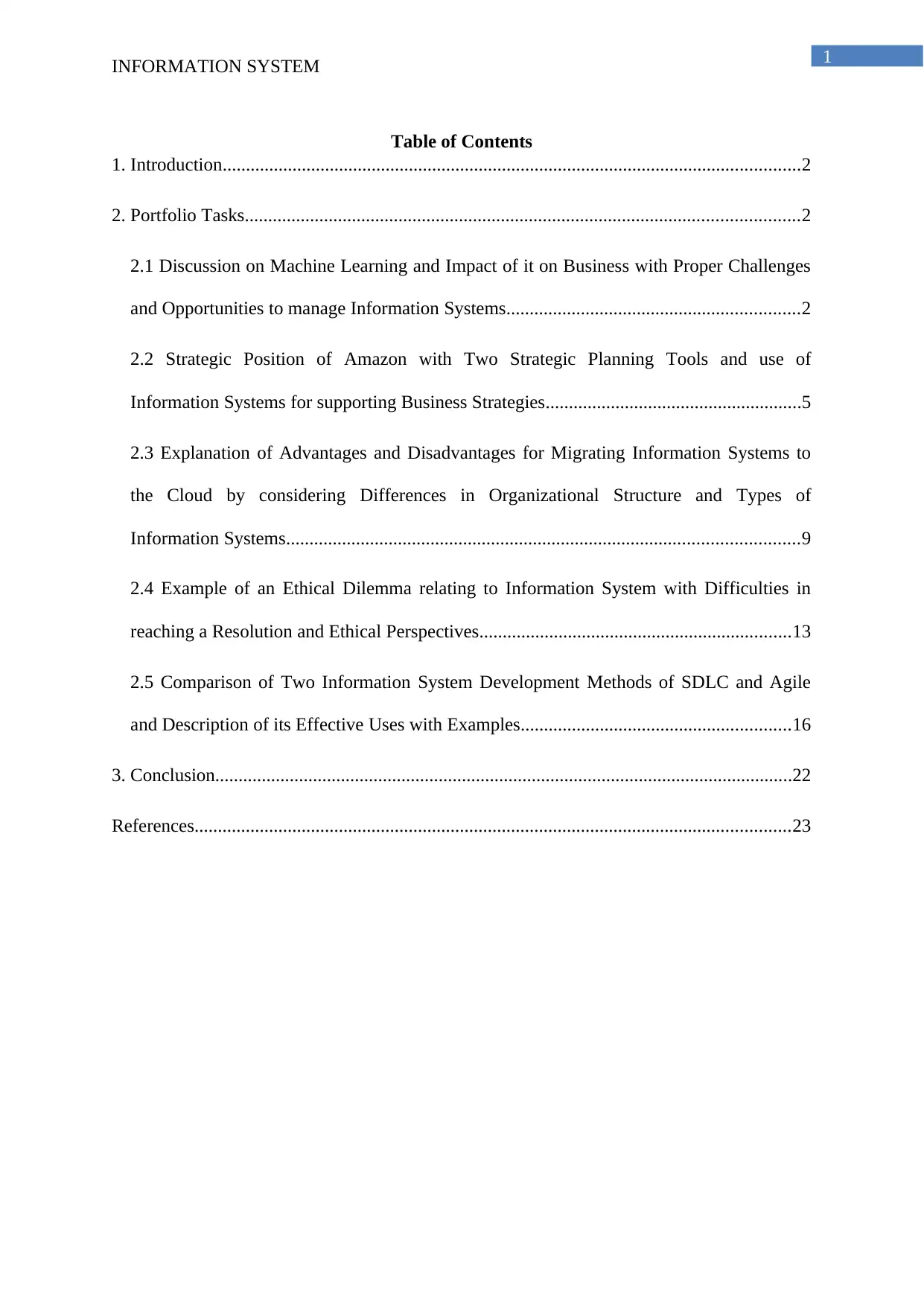
1
INFORMATION SYSTEM
Table of Contents
1. Introduction............................................................................................................................2
2. Portfolio Tasks.......................................................................................................................2
2.1 Discussion on Machine Learning and Impact of it on Business with Proper Challenges
and Opportunities to manage Information Systems...............................................................2
2.2 Strategic Position of Amazon with Two Strategic Planning Tools and use of
Information Systems for supporting Business Strategies.......................................................5
2.3 Explanation of Advantages and Disadvantages for Migrating Information Systems to
the Cloud by considering Differences in Organizational Structure and Types of
Information Systems..............................................................................................................9
2.4 Example of an Ethical Dilemma relating to Information System with Difficulties in
reaching a Resolution and Ethical Perspectives...................................................................13
2.5 Comparison of Two Information System Development Methods of SDLC and Agile
and Description of its Effective Uses with Examples..........................................................16
3. Conclusion............................................................................................................................22
References................................................................................................................................23
INFORMATION SYSTEM
Table of Contents
1. Introduction............................................................................................................................2
2. Portfolio Tasks.......................................................................................................................2
2.1 Discussion on Machine Learning and Impact of it on Business with Proper Challenges
and Opportunities to manage Information Systems...............................................................2
2.2 Strategic Position of Amazon with Two Strategic Planning Tools and use of
Information Systems for supporting Business Strategies.......................................................5
2.3 Explanation of Advantages and Disadvantages for Migrating Information Systems to
the Cloud by considering Differences in Organizational Structure and Types of
Information Systems..............................................................................................................9
2.4 Example of an Ethical Dilemma relating to Information System with Difficulties in
reaching a Resolution and Ethical Perspectives...................................................................13
2.5 Comparison of Two Information System Development Methods of SDLC and Agile
and Description of its Effective Uses with Examples..........................................................16
3. Conclusion............................................................................................................................22
References................................................................................................................................23
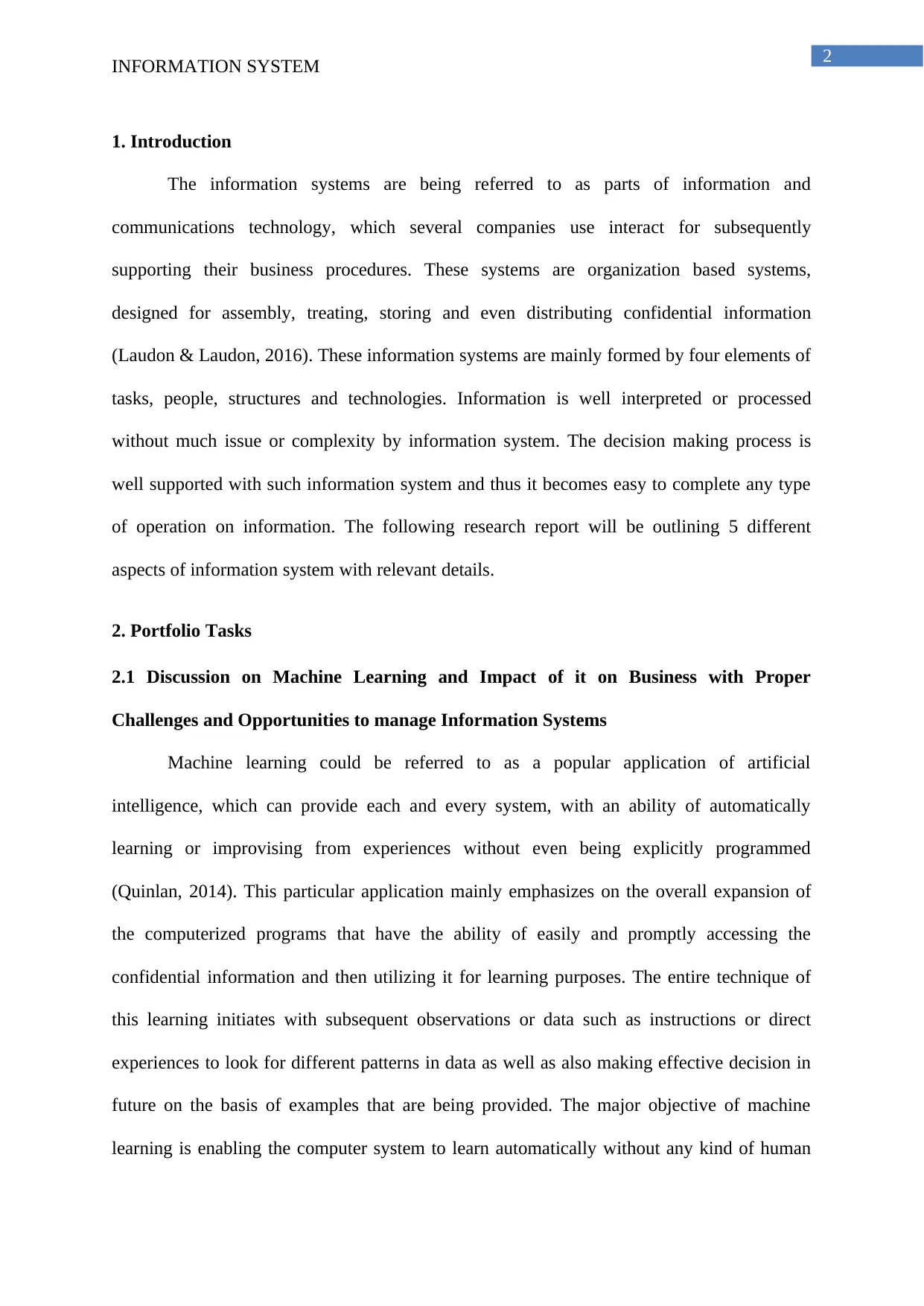
2
INFORMATION SYSTEM
1. Introduction
The information systems are being referred to as parts of information and
communications technology, which several companies use interact for subsequently
supporting their business procedures. These systems are organization based systems,
designed for assembly, treating, storing and even distributing confidential information
(Laudon & Laudon, 2016). These information systems are mainly formed by four elements of
tasks, people, structures and technologies. Information is well interpreted or processed
without much issue or complexity by information system. The decision making process is
well supported with such information system and thus it becomes easy to complete any type
of operation on information. The following research report will be outlining 5 different
aspects of information system with relevant details.
2. Portfolio Tasks
2.1 Discussion on Machine Learning and Impact of it on Business with Proper
Challenges and Opportunities to manage Information Systems
Machine learning could be referred to as a popular application of artificial
intelligence, which can provide each and every system, with an ability of automatically
learning or improvising from experiences without even being explicitly programmed
(Quinlan, 2014). This particular application mainly emphasizes on the overall expansion of
the computerized programs that have the ability of easily and promptly accessing the
confidential information and then utilizing it for learning purposes. The entire technique of
this learning initiates with subsequent observations or data such as instructions or direct
experiences to look for different patterns in data as well as also making effective decision in
future on the basis of examples that are being provided. The major objective of machine
learning is enabling the computer system to learn automatically without any kind of human
INFORMATION SYSTEM
1. Introduction
The information systems are being referred to as parts of information and
communications technology, which several companies use interact for subsequently
supporting their business procedures. These systems are organization based systems,
designed for assembly, treating, storing and even distributing confidential information
(Laudon & Laudon, 2016). These information systems are mainly formed by four elements of
tasks, people, structures and technologies. Information is well interpreted or processed
without much issue or complexity by information system. The decision making process is
well supported with such information system and thus it becomes easy to complete any type
of operation on information. The following research report will be outlining 5 different
aspects of information system with relevant details.
2. Portfolio Tasks
2.1 Discussion on Machine Learning and Impact of it on Business with Proper
Challenges and Opportunities to manage Information Systems
Machine learning could be referred to as a popular application of artificial
intelligence, which can provide each and every system, with an ability of automatically
learning or improvising from experiences without even being explicitly programmed
(Quinlan, 2014). This particular application mainly emphasizes on the overall expansion of
the computerized programs that have the ability of easily and promptly accessing the
confidential information and then utilizing it for learning purposes. The entire technique of
this learning initiates with subsequent observations or data such as instructions or direct
experiences to look for different patterns in data as well as also making effective decision in
future on the basis of examples that are being provided. The major objective of machine
learning is enabling the computer system to learn automatically without any kind of human
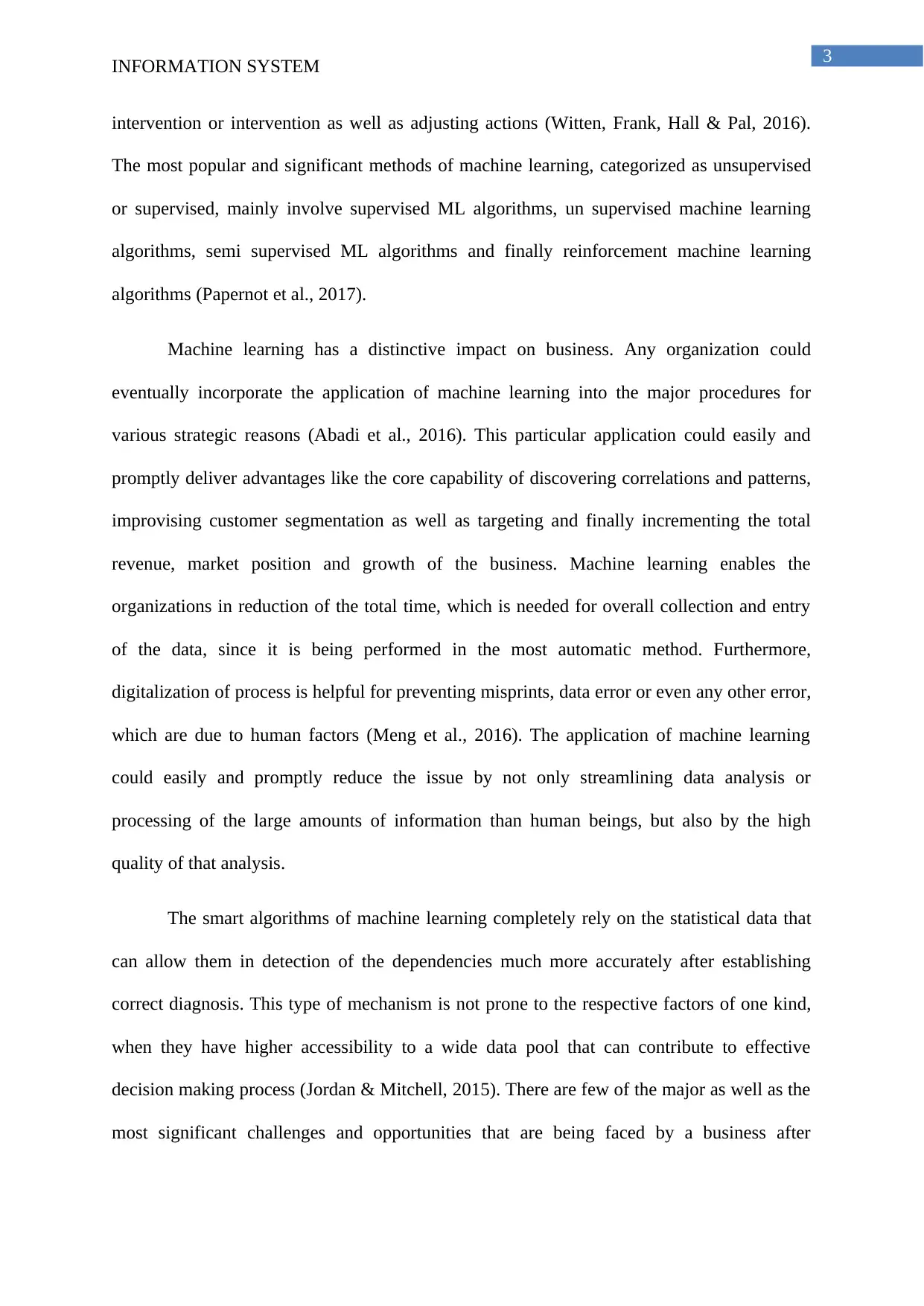
3
INFORMATION SYSTEM
intervention or intervention as well as adjusting actions (Witten, Frank, Hall & Pal, 2016).
The most popular and significant methods of machine learning, categorized as unsupervised
or supervised, mainly involve supervised ML algorithms, un supervised machine learning
algorithms, semi supervised ML algorithms and finally reinforcement machine learning
algorithms (Papernot et al., 2017).
Machine learning has a distinctive impact on business. Any organization could
eventually incorporate the application of machine learning into the major procedures for
various strategic reasons (Abadi et al., 2016). This particular application could easily and
promptly deliver advantages like the core capability of discovering correlations and patterns,
improvising customer segmentation as well as targeting and finally incrementing the total
revenue, market position and growth of the business. Machine learning enables the
organizations in reduction of the total time, which is needed for overall collection and entry
of the data, since it is being performed in the most automatic method. Furthermore,
digitalization of process is helpful for preventing misprints, data error or even any other error,
which are due to human factors (Meng et al., 2016). The application of machine learning
could easily and promptly reduce the issue by not only streamlining data analysis or
processing of the large amounts of information than human beings, but also by the high
quality of that analysis.
The smart algorithms of machine learning completely rely on the statistical data that
can allow them in detection of the dependencies much more accurately after establishing
correct diagnosis. This type of mechanism is not prone to the respective factors of one kind,
when they have higher accessibility to a wide data pool that can contribute to effective
decision making process (Jordan & Mitchell, 2015). There are few of the major as well as the
most significant challenges and opportunities that are being faced by a business after
INFORMATION SYSTEM
intervention or intervention as well as adjusting actions (Witten, Frank, Hall & Pal, 2016).
The most popular and significant methods of machine learning, categorized as unsupervised
or supervised, mainly involve supervised ML algorithms, un supervised machine learning
algorithms, semi supervised ML algorithms and finally reinforcement machine learning
algorithms (Papernot et al., 2017).
Machine learning has a distinctive impact on business. Any organization could
eventually incorporate the application of machine learning into the major procedures for
various strategic reasons (Abadi et al., 2016). This particular application could easily and
promptly deliver advantages like the core capability of discovering correlations and patterns,
improvising customer segmentation as well as targeting and finally incrementing the total
revenue, market position and growth of the business. Machine learning enables the
organizations in reduction of the total time, which is needed for overall collection and entry
of the data, since it is being performed in the most automatic method. Furthermore,
digitalization of process is helpful for preventing misprints, data error or even any other error,
which are due to human factors (Meng et al., 2016). The application of machine learning
could easily and promptly reduce the issue by not only streamlining data analysis or
processing of the large amounts of information than human beings, but also by the high
quality of that analysis.
The smart algorithms of machine learning completely rely on the statistical data that
can allow them in detection of the dependencies much more accurately after establishing
correct diagnosis. This type of mechanism is not prone to the respective factors of one kind,
when they have higher accessibility to a wide data pool that can contribute to effective
decision making process (Jordan & Mitchell, 2015). There are few of the major as well as the
most significant challenges and opportunities that are being faced by a business after
Secure Best Marks with AI Grader
Need help grading? Try our AI Grader for instant feedback on your assignments.
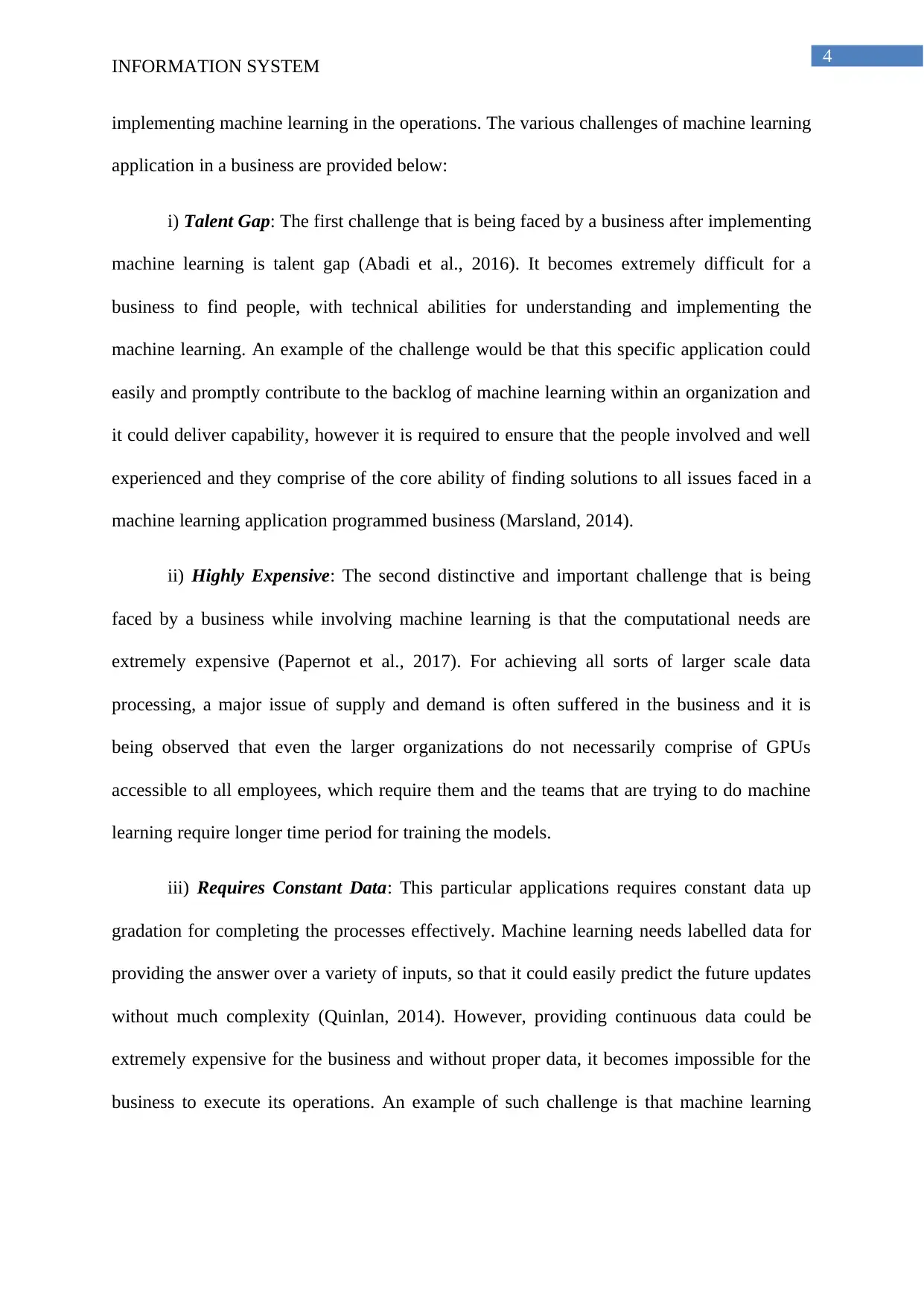
4
INFORMATION SYSTEM
implementing machine learning in the operations. The various challenges of machine learning
application in a business are provided below:
i) Talent Gap: The first challenge that is being faced by a business after implementing
machine learning is talent gap (Abadi et al., 2016). It becomes extremely difficult for a
business to find people, with technical abilities for understanding and implementing the
machine learning. An example of the challenge would be that this specific application could
easily and promptly contribute to the backlog of machine learning within an organization and
it could deliver capability, however it is required to ensure that the people involved and well
experienced and they comprise of the core ability of finding solutions to all issues faced in a
machine learning application programmed business (Marsland, 2014).
ii) Highly Expensive: The second distinctive and important challenge that is being
faced by a business while involving machine learning is that the computational needs are
extremely expensive (Papernot et al., 2017). For achieving all sorts of larger scale data
processing, a major issue of supply and demand is often suffered in the business and it is
being observed that even the larger organizations do not necessarily comprise of GPUs
accessible to all employees, which require them and the teams that are trying to do machine
learning require longer time period for training the models.
iii) Requires Constant Data: This particular applications requires constant data up
gradation for completing the processes effectively. Machine learning needs labelled data for
providing the answer over a variety of inputs, so that it could easily predict the future updates
without much complexity (Quinlan, 2014). However, providing continuous data could be
extremely expensive for the business and without proper data, it becomes impossible for the
business to execute its operations. An example of such challenge is that machine learning
INFORMATION SYSTEM
implementing machine learning in the operations. The various challenges of machine learning
application in a business are provided below:
i) Talent Gap: The first challenge that is being faced by a business after implementing
machine learning is talent gap (Abadi et al., 2016). It becomes extremely difficult for a
business to find people, with technical abilities for understanding and implementing the
machine learning. An example of the challenge would be that this specific application could
easily and promptly contribute to the backlog of machine learning within an organization and
it could deliver capability, however it is required to ensure that the people involved and well
experienced and they comprise of the core ability of finding solutions to all issues faced in a
machine learning application programmed business (Marsland, 2014).
ii) Highly Expensive: The second distinctive and important challenge that is being
faced by a business while involving machine learning is that the computational needs are
extremely expensive (Papernot et al., 2017). For achieving all sorts of larger scale data
processing, a major issue of supply and demand is often suffered in the business and it is
being observed that even the larger organizations do not necessarily comprise of GPUs
accessible to all employees, which require them and the teams that are trying to do machine
learning require longer time period for training the models.
iii) Requires Constant Data: This particular applications requires constant data up
gradation for completing the processes effectively. Machine learning needs labelled data for
providing the answer over a variety of inputs, so that it could easily predict the future updates
without much complexity (Quinlan, 2014). However, providing continuous data could be
extremely expensive for the business and without proper data, it becomes impossible for the
business to execute its operations. An example of such challenge is that machine learning
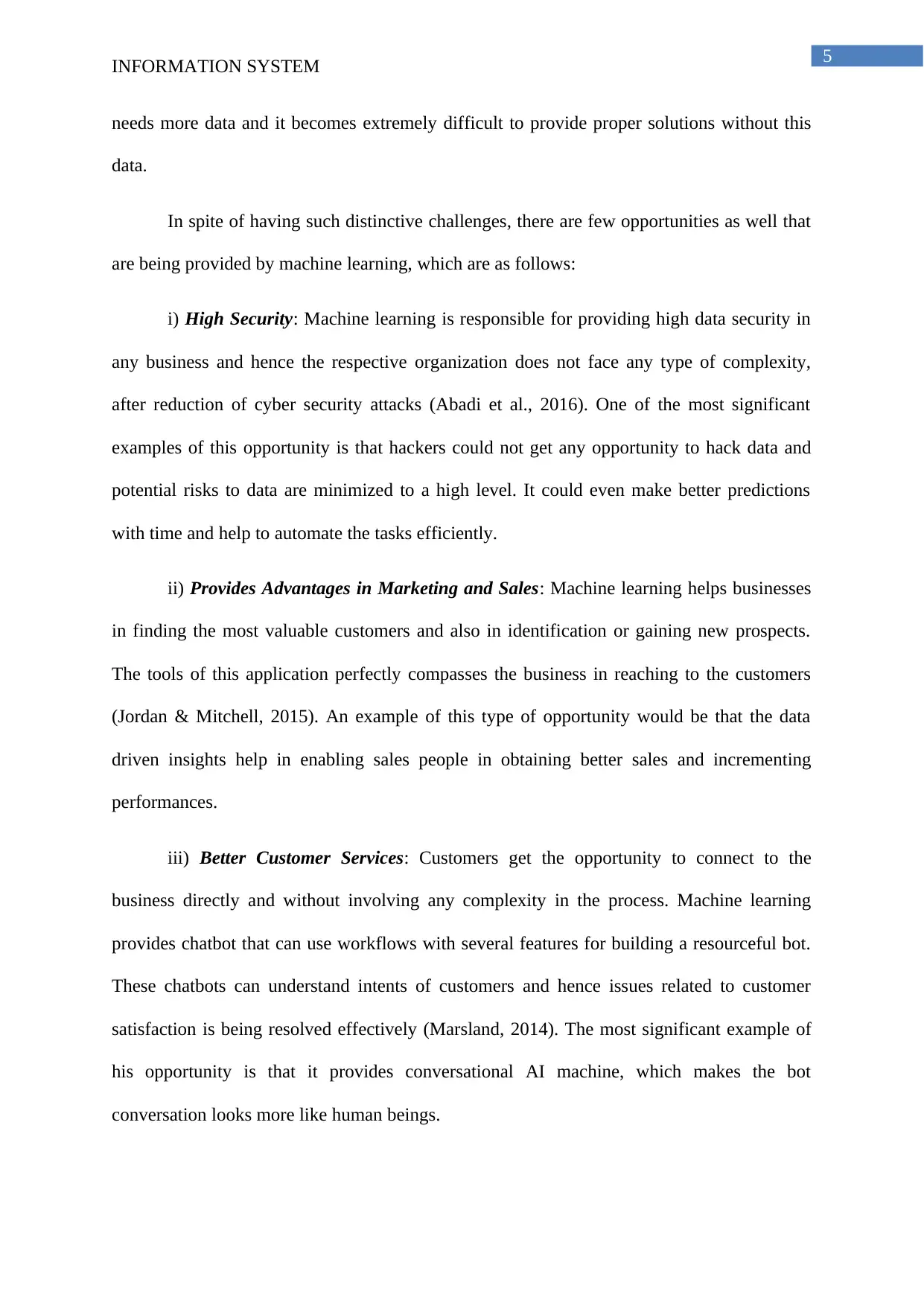
5
INFORMATION SYSTEM
needs more data and it becomes extremely difficult to provide proper solutions without this
data.
In spite of having such distinctive challenges, there are few opportunities as well that
are being provided by machine learning, which are as follows:
i) High Security: Machine learning is responsible for providing high data security in
any business and hence the respective organization does not face any type of complexity,
after reduction of cyber security attacks (Abadi et al., 2016). One of the most significant
examples of this opportunity is that hackers could not get any opportunity to hack data and
potential risks to data are minimized to a high level. It could even make better predictions
with time and help to automate the tasks efficiently.
ii) Provides Advantages in Marketing and Sales: Machine learning helps businesses
in finding the most valuable customers and also in identification or gaining new prospects.
The tools of this application perfectly compasses the business in reaching to the customers
(Jordan & Mitchell, 2015). An example of this type of opportunity would be that the data
driven insights help in enabling sales people in obtaining better sales and incrementing
performances.
iii) Better Customer Services: Customers get the opportunity to connect to the
business directly and without involving any complexity in the process. Machine learning
provides chatbot that can use workflows with several features for building a resourceful bot.
These chatbots can understand intents of customers and hence issues related to customer
satisfaction is being resolved effectively (Marsland, 2014). The most significant example of
his opportunity is that it provides conversational AI machine, which makes the bot
conversation looks more like human beings.
INFORMATION SYSTEM
needs more data and it becomes extremely difficult to provide proper solutions without this
data.
In spite of having such distinctive challenges, there are few opportunities as well that
are being provided by machine learning, which are as follows:
i) High Security: Machine learning is responsible for providing high data security in
any business and hence the respective organization does not face any type of complexity,
after reduction of cyber security attacks (Abadi et al., 2016). One of the most significant
examples of this opportunity is that hackers could not get any opportunity to hack data and
potential risks to data are minimized to a high level. It could even make better predictions
with time and help to automate the tasks efficiently.
ii) Provides Advantages in Marketing and Sales: Machine learning helps businesses
in finding the most valuable customers and also in identification or gaining new prospects.
The tools of this application perfectly compasses the business in reaching to the customers
(Jordan & Mitchell, 2015). An example of this type of opportunity would be that the data
driven insights help in enabling sales people in obtaining better sales and incrementing
performances.
iii) Better Customer Services: Customers get the opportunity to connect to the
business directly and without involving any complexity in the process. Machine learning
provides chatbot that can use workflows with several features for building a resourceful bot.
These chatbots can understand intents of customers and hence issues related to customer
satisfaction is being resolved effectively (Marsland, 2014). The most significant example of
his opportunity is that it provides conversational AI machine, which makes the bot
conversation looks more like human beings.

6
INFORMATION SYSTEM
2.2 Strategic Position of Amazon with Two Strategic Planning Tools and use of
Information Systems for supporting Business Strategies
Amazon.com is one of the most popular multinational technology-based organization
in America, which mainly focuses on electronic commerce, digital streaming, artificial
intelligence and cloud computing. It is popular for its subsequent disruption of every well
established industry by technological innovation (Amazon Strategies. 2018). Due to the
popularity in online businesses, they are being measured by market capitalization and
revenue. The strategic position of Amazon has been always on top and they had the ability of
maintaining sustainable competitive advantage on the basis of three operational strategies.
The first and the foremost strategy of this particular e business is low cost leadership
that provides the customers products with the lowest prices and hence business can easily
create demands for the products (Laudon & Laudon, 2016). The second distinctive strategy is
customer differentiation, which helps Amazon in differentiating the customer base in an
effective manner. The final strategy of this organization is focus strategies, which refer to the
marketing strategies, where Amazon is concentrating the resources for growing or entering
into the industry segments and narrow markets. It is generally employed, in which the
organization knows its segment and comprise of products for competitively satisfying the
needs.
Two effective and efficient strategic planning tools that can be useful for the
evaluation of strategic position of the organization of Amazon are provided below:
i) SWOT Analysis: The strengths of Amazon’s strategic position are given below:
a) Amazon can derive its strengths from a 3 pronged strategic drive on focus,
customer differentiation as well as cost leadership (Laudon & Laudon, 2015). It has resulted
INFORMATION SYSTEM
2.2 Strategic Position of Amazon with Two Strategic Planning Tools and use of
Information Systems for supporting Business Strategies
Amazon.com is one of the most popular multinational technology-based organization
in America, which mainly focuses on electronic commerce, digital streaming, artificial
intelligence and cloud computing. It is popular for its subsequent disruption of every well
established industry by technological innovation (Amazon Strategies. 2018). Due to the
popularity in online businesses, they are being measured by market capitalization and
revenue. The strategic position of Amazon has been always on top and they had the ability of
maintaining sustainable competitive advantage on the basis of three operational strategies.
The first and the foremost strategy of this particular e business is low cost leadership
that provides the customers products with the lowest prices and hence business can easily
create demands for the products (Laudon & Laudon, 2016). The second distinctive strategy is
customer differentiation, which helps Amazon in differentiating the customer base in an
effective manner. The final strategy of this organization is focus strategies, which refer to the
marketing strategies, where Amazon is concentrating the resources for growing or entering
into the industry segments and narrow markets. It is generally employed, in which the
organization knows its segment and comprise of products for competitively satisfying the
needs.
Two effective and efficient strategic planning tools that can be useful for the
evaluation of strategic position of the organization of Amazon are provided below:
i) SWOT Analysis: The strengths of Amazon’s strategic position are given below:
a) Amazon can derive its strengths from a 3 pronged strategic drive on focus,
customer differentiation as well as cost leadership (Laudon & Laudon, 2015). It has resulted
Paraphrase This Document
Need a fresh take? Get an instant paraphrase of this document with our AI Paraphraser

7
INFORMATION SYSTEM
in the organization reaping the gains from various actions and even helping the shareholders
to derive value from the business.
b) Amazon derives the major competitive benefits from leveraging IT as well as its
utilization of e commerce as the scalable ramp up platform for ensuring that the organization
is much ahead of the competitors (Enck et al., 2014).
The weaknesses of Amazon’s strategic position are given below:
a) Amazon has recently kept its attention for wavering from the major competences of
retailing online books and even enabled itself for venturing onto new focus areas (Theorin et
al., 2017). It did not a strategic advantage for moving from the core competency.
b) Since they offer free shipping to the customers, there is a high chance that the
margins might be lost and they would not be able to optimize the costs.
The opportunities of Amazon’s strategic position are given below:
a) Amazon has the core opportunity for scaling up considerably considering the
factor, which concerns on online shopping and hence security is concerned as one of the
major issues for customers (Bajdor & Grabara, 2014).
b) Amazon can easily increment the portfolio of the offerings and thus they could
stock much more products under the specific brand and forwarding third party products.
The threats of Amazon’s strategic position are given below:
a) One of these major risks of Amazon.com would be the incrementing concern about
online shopping for hacking and identity thefts that could involve exposure of consumer data
(Dumais et al., 2015).
INFORMATION SYSTEM
in the organization reaping the gains from various actions and even helping the shareholders
to derive value from the business.
b) Amazon derives the major competitive benefits from leveraging IT as well as its
utilization of e commerce as the scalable ramp up platform for ensuring that the organization
is much ahead of the competitors (Enck et al., 2014).
The weaknesses of Amazon’s strategic position are given below:
a) Amazon has recently kept its attention for wavering from the major competences of
retailing online books and even enabled itself for venturing onto new focus areas (Theorin et
al., 2017). It did not a strategic advantage for moving from the core competency.
b) Since they offer free shipping to the customers, there is a high chance that the
margins might be lost and they would not be able to optimize the costs.
The opportunities of Amazon’s strategic position are given below:
a) Amazon has the core opportunity for scaling up considerably considering the
factor, which concerns on online shopping and hence security is concerned as one of the
major issues for customers (Bajdor & Grabara, 2014).
b) Amazon can easily increment the portfolio of the offerings and thus they could
stock much more products under the specific brand and forwarding third party products.
The threats of Amazon’s strategic position are given below:
a) One of these major risks of Amazon.com would be the incrementing concern about
online shopping for hacking and identity thefts that could involve exposure of consumer data
(Dumais et al., 2015).
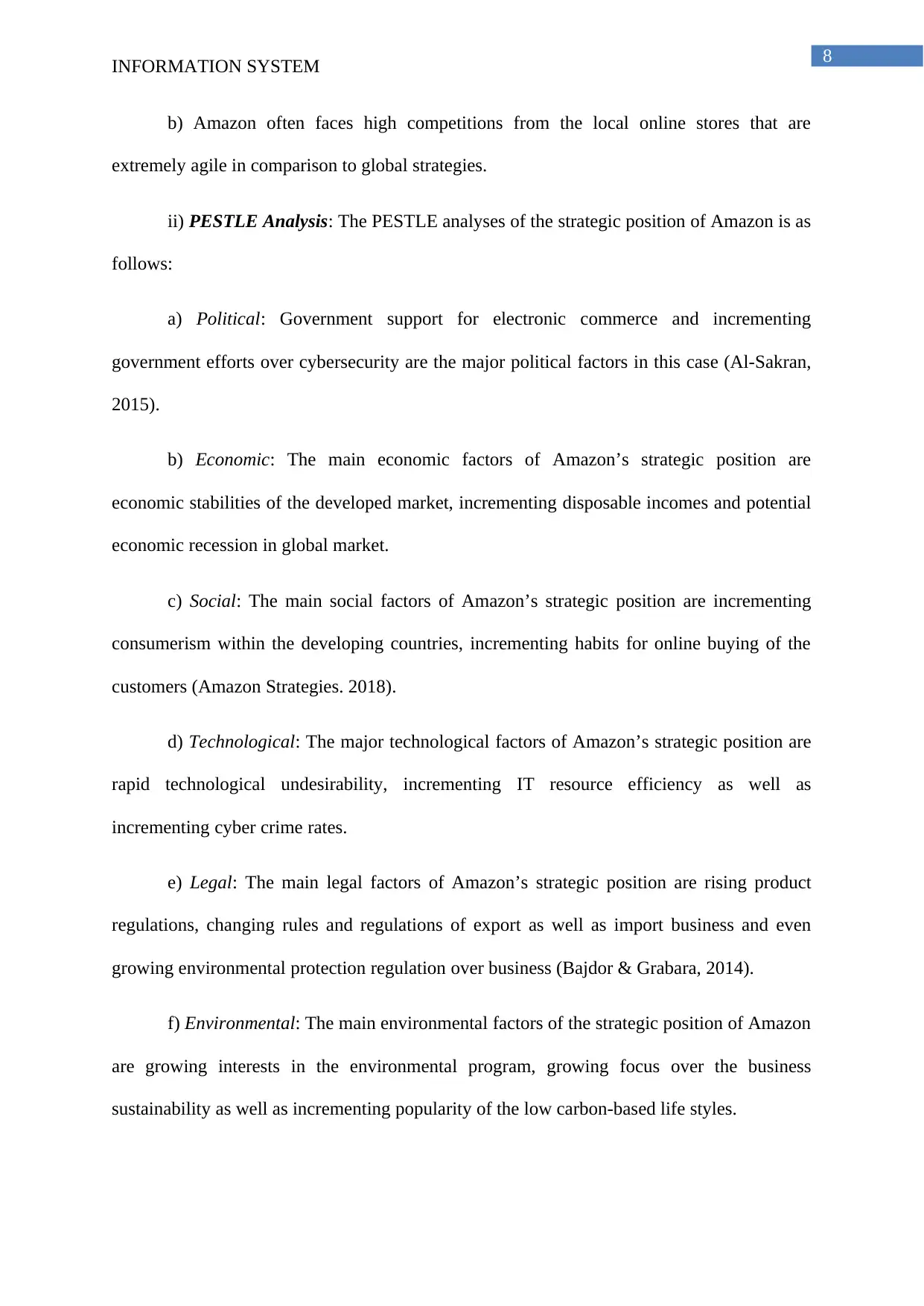
8
INFORMATION SYSTEM
b) Amazon often faces high competitions from the local online stores that are
extremely agile in comparison to global strategies.
ii) PESTLE Analysis: The PESTLE analyses of the strategic position of Amazon is as
follows:
a) Political: Government support for electronic commerce and incrementing
government efforts over cybersecurity are the major political factors in this case (Al-Sakran,
2015).
b) Economic: The main economic factors of Amazon’s strategic position are
economic stabilities of the developed market, incrementing disposable incomes and potential
economic recession in global market.
c) Social: The main social factors of Amazon’s strategic position are incrementing
consumerism within the developing countries, incrementing habits for online buying of the
customers (Amazon Strategies. 2018).
d) Technological: The major technological factors of Amazon’s strategic position are
rapid technological undesirability, incrementing IT resource efficiency as well as
incrementing cyber crime rates.
e) Legal: The main legal factors of Amazon’s strategic position are rising product
regulations, changing rules and regulations of export as well as import business and even
growing environmental protection regulation over business (Bajdor & Grabara, 2014).
f) Environmental: The main environmental factors of the strategic position of Amazon
are growing interests in the environmental program, growing focus over the business
sustainability as well as incrementing popularity of the low carbon-based life styles.
INFORMATION SYSTEM
b) Amazon often faces high competitions from the local online stores that are
extremely agile in comparison to global strategies.
ii) PESTLE Analysis: The PESTLE analyses of the strategic position of Amazon is as
follows:
a) Political: Government support for electronic commerce and incrementing
government efforts over cybersecurity are the major political factors in this case (Al-Sakran,
2015).
b) Economic: The main economic factors of Amazon’s strategic position are
economic stabilities of the developed market, incrementing disposable incomes and potential
economic recession in global market.
c) Social: The main social factors of Amazon’s strategic position are incrementing
consumerism within the developing countries, incrementing habits for online buying of the
customers (Amazon Strategies. 2018).
d) Technological: The major technological factors of Amazon’s strategic position are
rapid technological undesirability, incrementing IT resource efficiency as well as
incrementing cyber crime rates.
e) Legal: The main legal factors of Amazon’s strategic position are rising product
regulations, changing rules and regulations of export as well as import business and even
growing environmental protection regulation over business (Bajdor & Grabara, 2014).
f) Environmental: The main environmental factors of the strategic position of Amazon
are growing interests in the environmental program, growing focus over the business
sustainability as well as incrementing popularity of the low carbon-based life styles.
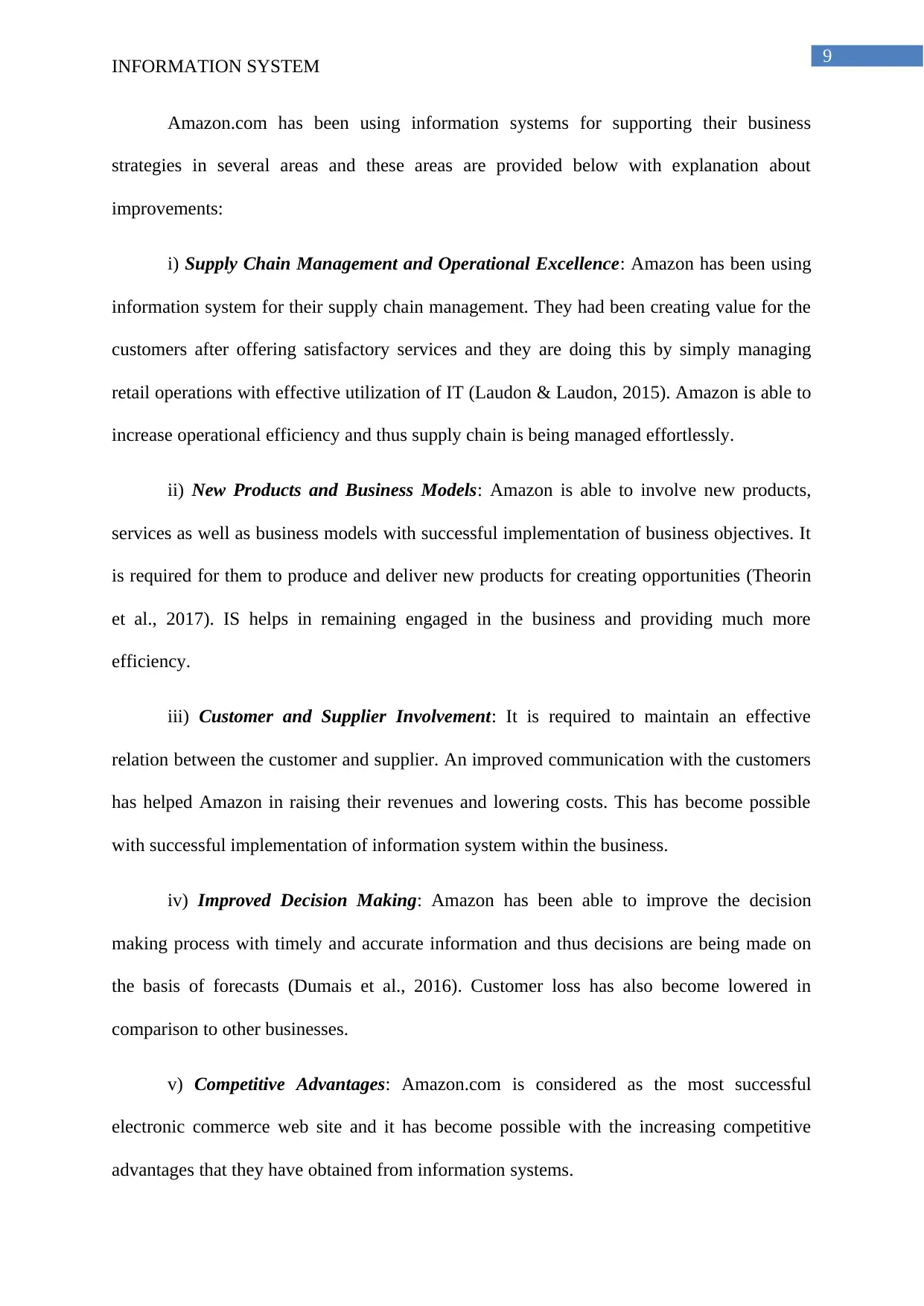
9
INFORMATION SYSTEM
Amazon.com has been using information systems for supporting their business
strategies in several areas and these areas are provided below with explanation about
improvements:
i) Supply Chain Management and Operational Excellence: Amazon has been using
information system for their supply chain management. They had been creating value for the
customers after offering satisfactory services and they are doing this by simply managing
retail operations with effective utilization of IT (Laudon & Laudon, 2015). Amazon is able to
increase operational efficiency and thus supply chain is being managed effortlessly.
ii) New Products and Business Models: Amazon is able to involve new products,
services as well as business models with successful implementation of business objectives. It
is required for them to produce and deliver new products for creating opportunities (Theorin
et al., 2017). IS helps in remaining engaged in the business and providing much more
efficiency.
iii) Customer and Supplier Involvement: It is required to maintain an effective
relation between the customer and supplier. An improved communication with the customers
has helped Amazon in raising their revenues and lowering costs. This has become possible
with successful implementation of information system within the business.
iv) Improved Decision Making: Amazon has been able to improve the decision
making process with timely and accurate information and thus decisions are being made on
the basis of forecasts (Dumais et al., 2016). Customer loss has also become lowered in
comparison to other businesses.
v) Competitive Advantages: Amazon.com is considered as the most successful
electronic commerce web site and it has become possible with the increasing competitive
advantages that they have obtained from information systems.
INFORMATION SYSTEM
Amazon.com has been using information systems for supporting their business
strategies in several areas and these areas are provided below with explanation about
improvements:
i) Supply Chain Management and Operational Excellence: Amazon has been using
information system for their supply chain management. They had been creating value for the
customers after offering satisfactory services and they are doing this by simply managing
retail operations with effective utilization of IT (Laudon & Laudon, 2015). Amazon is able to
increase operational efficiency and thus supply chain is being managed effortlessly.
ii) New Products and Business Models: Amazon is able to involve new products,
services as well as business models with successful implementation of business objectives. It
is required for them to produce and deliver new products for creating opportunities (Theorin
et al., 2017). IS helps in remaining engaged in the business and providing much more
efficiency.
iii) Customer and Supplier Involvement: It is required to maintain an effective
relation between the customer and supplier. An improved communication with the customers
has helped Amazon in raising their revenues and lowering costs. This has become possible
with successful implementation of information system within the business.
iv) Improved Decision Making: Amazon has been able to improve the decision
making process with timely and accurate information and thus decisions are being made on
the basis of forecasts (Dumais et al., 2016). Customer loss has also become lowered in
comparison to other businesses.
v) Competitive Advantages: Amazon.com is considered as the most successful
electronic commerce web site and it has become possible with the increasing competitive
advantages that they have obtained from information systems.
Secure Best Marks with AI Grader
Need help grading? Try our AI Grader for instant feedback on your assignments.

10
INFORMATION SYSTEM
The only area that is needed to be improved for Amazon with information system is
its survival (Al-Sakran, 2015). These systems are referred to as a necessity for doing business
and such necessity might be driven by industry level changes within the e commerce
industry. Amazon needs to improve this for better data retention.
2.3 Explanation of Advantages and Disadvantages for Migrating Information Systems
to the Cloud by considering Differences in Organizational Structure and Types of
Information Systems
Information systems are responsible for reducing the complexities of data
management to a high level and for this purpose, several popular and significant
organizations have implemented this technology in their businesses. In spite of having such
distinctive and important advantages, several organizations in present world are deciding to
migrate their information systems to cloud technology (Zhao & Zhou, 2014). Cloud
migration is the procedure to partially or completely deploy the IT resources, services, digital
assets, data and applications of a company over the respective cloud platform. The major
advantages of migrating information systems to the cloud are provided below:
i) High Scalability: The first advantage of migrating information system to cloud is
that scalability in cloud is extremely high. The growing businesses need extra space on the
cloud environment for coping up with the higher demands (Jamshidi, Pahl, Chinenyeze &
Liu, 2015). Cloud is referred to as the ideal platform for businesses with a fluctuating market.
The cloud based services could be leveraged for scaling up and scaling down of the
operational needs of IT infrastructure according to their changing situations.
ii) Automation in Software Updates: The second benefit of migrating information
system to cloud would be better automation in the software updates. This is possible only
because the applications are being hosted on the off premise servers (Balalaie, Heydarnoori &
INFORMATION SYSTEM
The only area that is needed to be improved for Amazon with information system is
its survival (Al-Sakran, 2015). These systems are referred to as a necessity for doing business
and such necessity might be driven by industry level changes within the e commerce
industry. Amazon needs to improve this for better data retention.
2.3 Explanation of Advantages and Disadvantages for Migrating Information Systems
to the Cloud by considering Differences in Organizational Structure and Types of
Information Systems
Information systems are responsible for reducing the complexities of data
management to a high level and for this purpose, several popular and significant
organizations have implemented this technology in their businesses. In spite of having such
distinctive and important advantages, several organizations in present world are deciding to
migrate their information systems to cloud technology (Zhao & Zhou, 2014). Cloud
migration is the procedure to partially or completely deploy the IT resources, services, digital
assets, data and applications of a company over the respective cloud platform. The major
advantages of migrating information systems to the cloud are provided below:
i) High Scalability: The first advantage of migrating information system to cloud is
that scalability in cloud is extremely high. The growing businesses need extra space on the
cloud environment for coping up with the higher demands (Jamshidi, Pahl, Chinenyeze &
Liu, 2015). Cloud is referred to as the ideal platform for businesses with a fluctuating market.
The cloud based services could be leveraged for scaling up and scaling down of the
operational needs of IT infrastructure according to their changing situations.
ii) Automation in Software Updates: The second benefit of migrating information
system to cloud would be better automation in the software updates. This is possible only
because the applications are being hosted on the off premise servers (Balalaie, Heydarnoori &

11
INFORMATION SYSTEM
Jamshidi, 2016). It helps in better maintenance of the IT infrastructure and cost is lowered to
a greater level.
iii) Lowered IT Costs: Cloud migration helps in lowering the IT costs and the
businesses could easily utilize the infrastructure and server capacity of the cloud service
provider only when the organizations ask for better usage of the third party IT resources like
infrastructure, server and hardware (Gholami, Daneshgar, Low & Beydoun, 2016). The
resources could be de-provisioned, if support is not required, thus reducing costs to a high
level.
iv) Disaster Recovery: Migration to cloud is also helpful in data protection as it is
referred to as the integral part of business continuity plan. The technology of cloud can take
up of backup of data at the most safe and secured location after protecting it from sudden
power failure or any other crisis.
v) Enhancement in Collaboration: Cloud migration is extremely helpful in
enhancing collaboration and the workforce is able to feel flexibility in utilization, editing and
sharing the documents and information within real time through shared storage (Rai, Sahoo &
Mehfuz, 2015). It allows the staff with virtual meetings with improvised collaboration,
development of products and customer services.
vi) Better Mobility: Cloud even provides better mobility to the business by providing
different types of cloud based data and applications so that data accessibility becomes much
easier in comparison to other technologies. The on field operations are well executed and it
provides better results to the clients.
Although, they comprise of several benefits, some of the disadvantages are also
present for migrating information systems to cloud and these disadvantages are provided
below:
INFORMATION SYSTEM
Jamshidi, 2016). It helps in better maintenance of the IT infrastructure and cost is lowered to
a greater level.
iii) Lowered IT Costs: Cloud migration helps in lowering the IT costs and the
businesses could easily utilize the infrastructure and server capacity of the cloud service
provider only when the organizations ask for better usage of the third party IT resources like
infrastructure, server and hardware (Gholami, Daneshgar, Low & Beydoun, 2016). The
resources could be de-provisioned, if support is not required, thus reducing costs to a high
level.
iv) Disaster Recovery: Migration to cloud is also helpful in data protection as it is
referred to as the integral part of business continuity plan. The technology of cloud can take
up of backup of data at the most safe and secured location after protecting it from sudden
power failure or any other crisis.
v) Enhancement in Collaboration: Cloud migration is extremely helpful in
enhancing collaboration and the workforce is able to feel flexibility in utilization, editing and
sharing the documents and information within real time through shared storage (Rai, Sahoo &
Mehfuz, 2015). It allows the staff with virtual meetings with improvised collaboration,
development of products and customer services.
vi) Better Mobility: Cloud even provides better mobility to the business by providing
different types of cloud based data and applications so that data accessibility becomes much
easier in comparison to other technologies. The on field operations are well executed and it
provides better results to the clients.
Although, they comprise of several benefits, some of the disadvantages are also
present for migrating information systems to cloud and these disadvantages are provided
below:
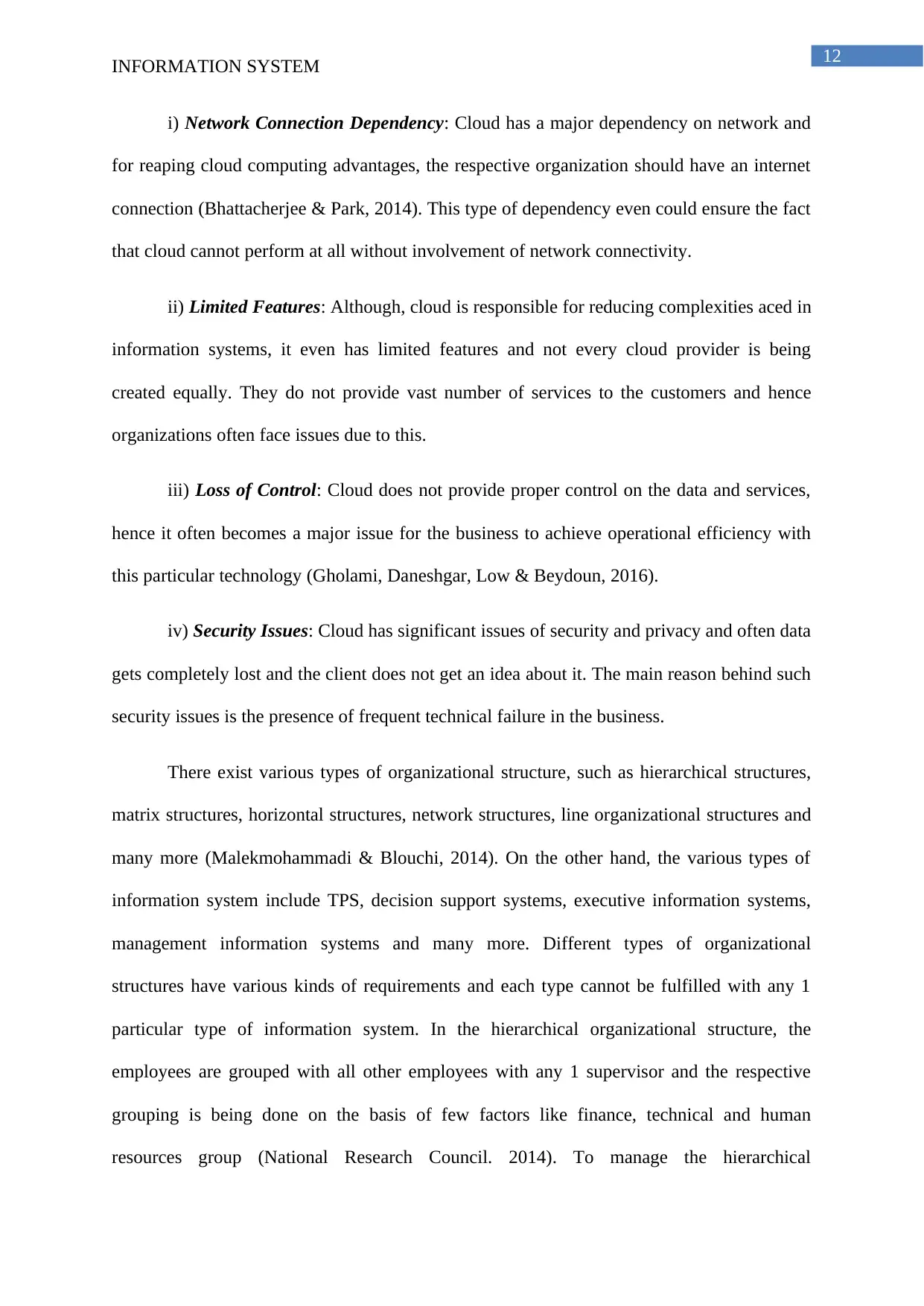
12
INFORMATION SYSTEM
i) Network Connection Dependency: Cloud has a major dependency on network and
for reaping cloud computing advantages, the respective organization should have an internet
connection (Bhattacherjee & Park, 2014). This type of dependency even could ensure the fact
that cloud cannot perform at all without involvement of network connectivity.
ii) Limited Features: Although, cloud is responsible for reducing complexities aced in
information systems, it even has limited features and not every cloud provider is being
created equally. They do not provide vast number of services to the customers and hence
organizations often face issues due to this.
iii) Loss of Control: Cloud does not provide proper control on the data and services,
hence it often becomes a major issue for the business to achieve operational efficiency with
this particular technology (Gholami, Daneshgar, Low & Beydoun, 2016).
iv) Security Issues: Cloud has significant issues of security and privacy and often data
gets completely lost and the client does not get an idea about it. The main reason behind such
security issues is the presence of frequent technical failure in the business.
There exist various types of organizational structure, such as hierarchical structures,
matrix structures, horizontal structures, network structures, line organizational structures and
many more (Malekmohammadi & Blouchi, 2014). On the other hand, the various types of
information system include TPS, decision support systems, executive information systems,
management information systems and many more. Different types of organizational
structures have various kinds of requirements and each type cannot be fulfilled with any 1
particular type of information system. In the hierarchical organizational structure, the
employees are grouped with all other employees with any 1 supervisor and the respective
grouping is being done on the basis of few factors like finance, technical and human
resources group (National Research Council. 2014). To manage the hierarchical
INFORMATION SYSTEM
i) Network Connection Dependency: Cloud has a major dependency on network and
for reaping cloud computing advantages, the respective organization should have an internet
connection (Bhattacherjee & Park, 2014). This type of dependency even could ensure the fact
that cloud cannot perform at all without involvement of network connectivity.
ii) Limited Features: Although, cloud is responsible for reducing complexities aced in
information systems, it even has limited features and not every cloud provider is being
created equally. They do not provide vast number of services to the customers and hence
organizations often face issues due to this.
iii) Loss of Control: Cloud does not provide proper control on the data and services,
hence it often becomes a major issue for the business to achieve operational efficiency with
this particular technology (Gholami, Daneshgar, Low & Beydoun, 2016).
iv) Security Issues: Cloud has significant issues of security and privacy and often data
gets completely lost and the client does not get an idea about it. The main reason behind such
security issues is the presence of frequent technical failure in the business.
There exist various types of organizational structure, such as hierarchical structures,
matrix structures, horizontal structures, network structures, line organizational structures and
many more (Malekmohammadi & Blouchi, 2014). On the other hand, the various types of
information system include TPS, decision support systems, executive information systems,
management information systems and many more. Different types of organizational
structures have various kinds of requirements and each type cannot be fulfilled with any 1
particular type of information system. In the hierarchical organizational structure, the
employees are grouped with all other employees with any 1 supervisor and the respective
grouping is being done on the basis of few factors like finance, technical and human
resources group (National Research Council. 2014). To manage the hierarchical
Paraphrase This Document
Need a fresh take? Get an instant paraphrase of this document with our AI Paraphraser

13
INFORMATION SYSTEM
organizational structure, it is required to implement decision support system, as better
decision making is required in comparison to other structures.
The second type of organizational structure is matrix structure, in which the
relationships are set up as grids or matrices and in this type of structure, the individuals with
same skills are being pooled for the subsequent work assignments and hence resulting in at
least two managers for reporting to. For such distinctive organizational structure, it is
required to involve management information system that is helpful in managing confidential
information in the most effective manner (Balalaie, Heydarnoori & Jamshidi, 2016). The
third type of organizational structure is horizontal structure, in which several levels of the
mid-management are being eradicated. It enables the staffs in making effective decisions
quite quickly as well as independently.
A well-groomed working force could be extremely fruitful after directly getting
included within the entire procedure of decision-making. Since, decision making process is
being shared with the employees as well, the executive information system is effective for
this information system as decisions are needed to be discussed with the employees as well
(Zhao & Zhou, 2014). An example of such information system utilization would be for a
restaurant case study. A restaurant has a hierarchical organizational structure, since
employees follow their supervisor. Thus, decision support system is effective for them for
taking proper decisions in respect profit planning, trends forecasting and many more.
2.4 Example of an Ethical Dilemma relating to Information System with Difficulties in
reaching a Resolution and Ethical Perspectives
A popular example of an ethical dilemma that is associated to information system is
from the case study of Marriott International. This particular organization is the most popular
hotel chain in the entire world (18 Biggest Data Breaches. 2018). It is an American
INFORMATION SYSTEM
organizational structure, it is required to implement decision support system, as better
decision making is required in comparison to other structures.
The second type of organizational structure is matrix structure, in which the
relationships are set up as grids or matrices and in this type of structure, the individuals with
same skills are being pooled for the subsequent work assignments and hence resulting in at
least two managers for reporting to. For such distinctive organizational structure, it is
required to involve management information system that is helpful in managing confidential
information in the most effective manner (Balalaie, Heydarnoori & Jamshidi, 2016). The
third type of organizational structure is horizontal structure, in which several levels of the
mid-management are being eradicated. It enables the staffs in making effective decisions
quite quickly as well as independently.
A well-groomed working force could be extremely fruitful after directly getting
included within the entire procedure of decision-making. Since, decision making process is
being shared with the employees as well, the executive information system is effective for
this information system as decisions are needed to be discussed with the employees as well
(Zhao & Zhou, 2014). An example of such information system utilization would be for a
restaurant case study. A restaurant has a hierarchical organizational structure, since
employees follow their supervisor. Thus, decision support system is effective for them for
taking proper decisions in respect profit planning, trends forecasting and many more.
2.4 Example of an Ethical Dilemma relating to Information System with Difficulties in
reaching a Resolution and Ethical Perspectives
A popular example of an ethical dilemma that is associated to information system is
from the case study of Marriott International. This particular organization is the most popular
hotel chain in the entire world (18 Biggest Data Breaches. 2018). It is an American
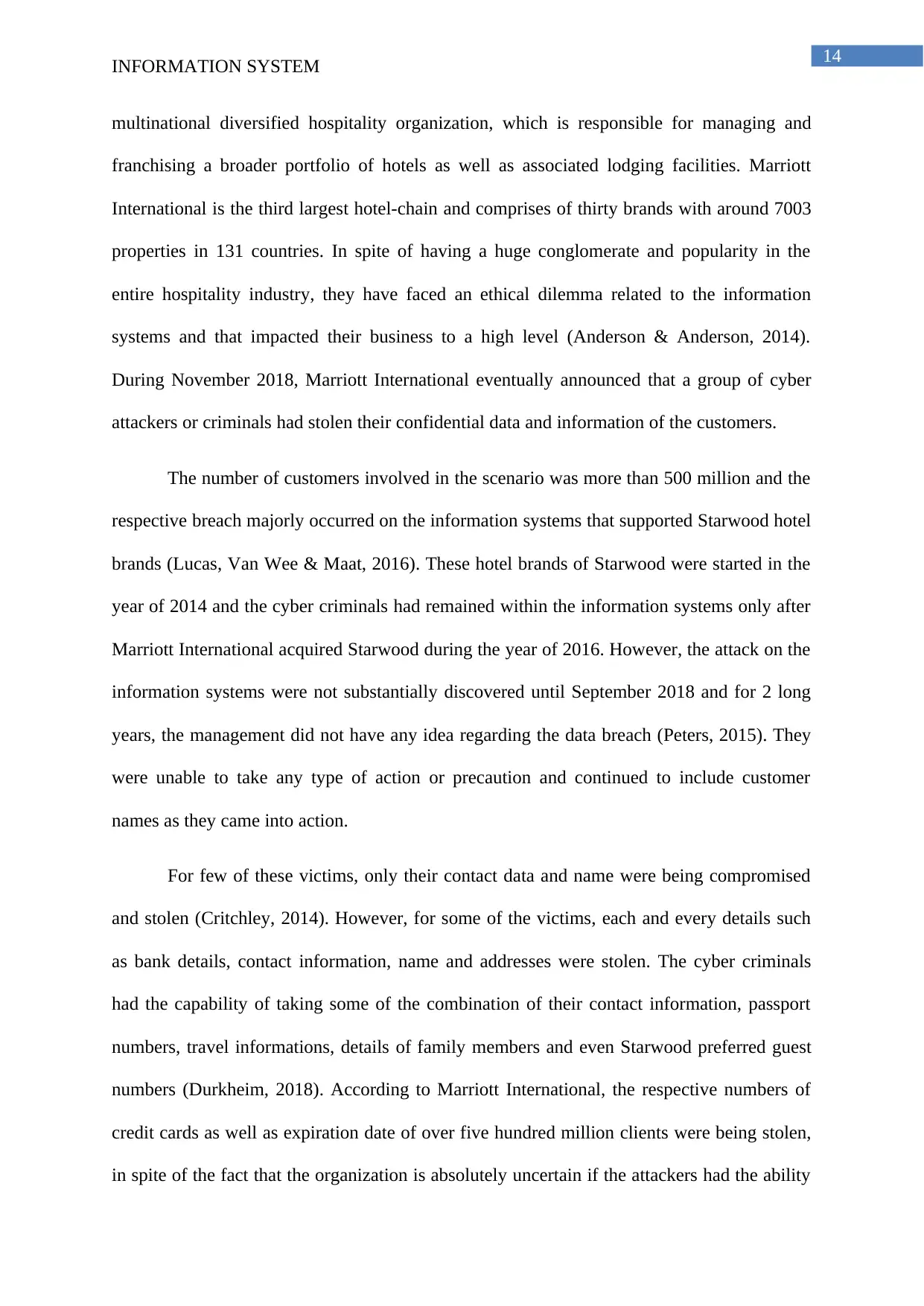
14
INFORMATION SYSTEM
multinational diversified hospitality organization, which is responsible for managing and
franchising a broader portfolio of hotels as well as associated lodging facilities. Marriott
International is the third largest hotel-chain and comprises of thirty brands with around 7003
properties in 131 countries. In spite of having a huge conglomerate and popularity in the
entire hospitality industry, they have faced an ethical dilemma related to the information
systems and that impacted their business to a high level (Anderson & Anderson, 2014).
During November 2018, Marriott International eventually announced that a group of cyber
attackers or criminals had stolen their confidential data and information of the customers.
The number of customers involved in the scenario was more than 500 million and the
respective breach majorly occurred on the information systems that supported Starwood hotel
brands (Lucas, Van Wee & Maat, 2016). These hotel brands of Starwood were started in the
year of 2014 and the cyber criminals had remained within the information systems only after
Marriott International acquired Starwood during the year of 2016. However, the attack on the
information systems were not substantially discovered until September 2018 and for 2 long
years, the management did not have any idea regarding the data breach (Peters, 2015). They
were unable to take any type of action or precaution and continued to include customer
names as they came into action.
For few of these victims, only their contact data and name were being compromised
and stolen (Critchley, 2014). However, for some of the victims, each and every details such
as bank details, contact information, name and addresses were stolen. The cyber criminals
had the capability of taking some of the combination of their contact information, passport
numbers, travel informations, details of family members and even Starwood preferred guest
numbers (Durkheim, 2018). According to Marriott International, the respective numbers of
credit cards as well as expiration date of over five hundred million clients were being stolen,
in spite of the fact that the organization is absolutely uncertain if the attackers had the ability
INFORMATION SYSTEM
multinational diversified hospitality organization, which is responsible for managing and
franchising a broader portfolio of hotels as well as associated lodging facilities. Marriott
International is the third largest hotel-chain and comprises of thirty brands with around 7003
properties in 131 countries. In spite of having a huge conglomerate and popularity in the
entire hospitality industry, they have faced an ethical dilemma related to the information
systems and that impacted their business to a high level (Anderson & Anderson, 2014).
During November 2018, Marriott International eventually announced that a group of cyber
attackers or criminals had stolen their confidential data and information of the customers.
The number of customers involved in the scenario was more than 500 million and the
respective breach majorly occurred on the information systems that supported Starwood hotel
brands (Lucas, Van Wee & Maat, 2016). These hotel brands of Starwood were started in the
year of 2014 and the cyber criminals had remained within the information systems only after
Marriott International acquired Starwood during the year of 2016. However, the attack on the
information systems were not substantially discovered until September 2018 and for 2 long
years, the management did not have any idea regarding the data breach (Peters, 2015). They
were unable to take any type of action or precaution and continued to include customer
names as they came into action.
For few of these victims, only their contact data and name were being compromised
and stolen (Critchley, 2014). However, for some of the victims, each and every details such
as bank details, contact information, name and addresses were stolen. The cyber criminals
had the capability of taking some of the combination of their contact information, passport
numbers, travel informations, details of family members and even Starwood preferred guest
numbers (Durkheim, 2018). According to Marriott International, the respective numbers of
credit cards as well as expiration date of over five hundred million clients were being stolen,
in spite of the fact that the organization is absolutely uncertain if the attackers had the ability
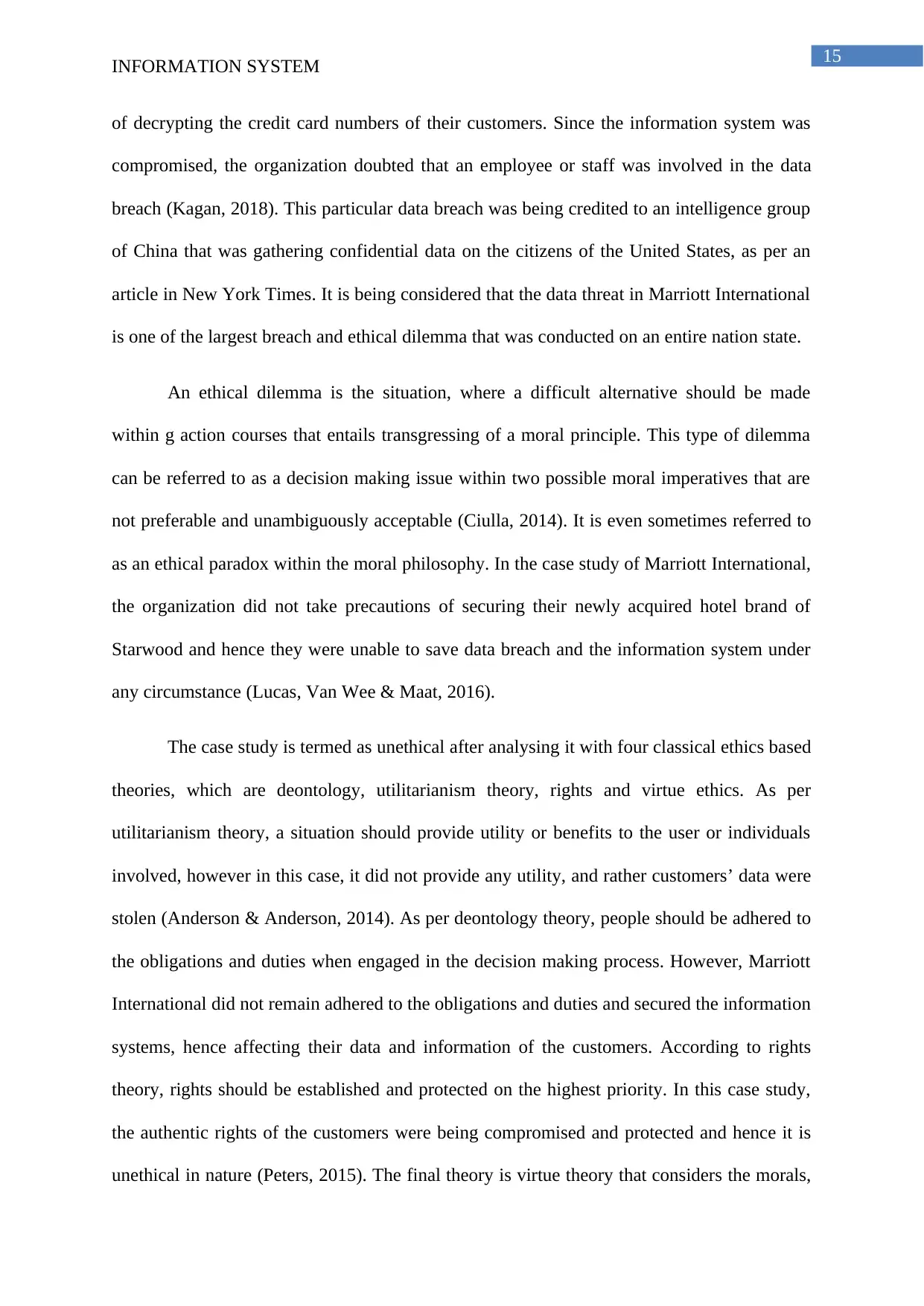
15
INFORMATION SYSTEM
of decrypting the credit card numbers of their customers. Since the information system was
compromised, the organization doubted that an employee or staff was involved in the data
breach (Kagan, 2018). This particular data breach was being credited to an intelligence group
of China that was gathering confidential data on the citizens of the United States, as per an
article in New York Times. It is being considered that the data threat in Marriott International
is one of the largest breach and ethical dilemma that was conducted on an entire nation state.
An ethical dilemma is the situation, where a difficult alternative should be made
within g action courses that entails transgressing of a moral principle. This type of dilemma
can be referred to as a decision making issue within two possible moral imperatives that are
not preferable and unambiguously acceptable (Ciulla, 2014). It is even sometimes referred to
as an ethical paradox within the moral philosophy. In the case study of Marriott International,
the organization did not take precautions of securing their newly acquired hotel brand of
Starwood and hence they were unable to save data breach and the information system under
any circumstance (Lucas, Van Wee & Maat, 2016).
The case study is termed as unethical after analysing it with four classical ethics based
theories, which are deontology, utilitarianism theory, rights and virtue ethics. As per
utilitarianism theory, a situation should provide utility or benefits to the user or individuals
involved, however in this case, it did not provide any utility, and rather customers’ data were
stolen (Anderson & Anderson, 2014). As per deontology theory, people should be adhered to
the obligations and duties when engaged in the decision making process. However, Marriott
International did not remain adhered to the obligations and duties and secured the information
systems, hence affecting their data and information of the customers. According to rights
theory, rights should be established and protected on the highest priority. In this case study,
the authentic rights of the customers were being compromised and protected and hence it is
unethical in nature (Peters, 2015). The final theory is virtue theory that considers the morals,
INFORMATION SYSTEM
of decrypting the credit card numbers of their customers. Since the information system was
compromised, the organization doubted that an employee or staff was involved in the data
breach (Kagan, 2018). This particular data breach was being credited to an intelligence group
of China that was gathering confidential data on the citizens of the United States, as per an
article in New York Times. It is being considered that the data threat in Marriott International
is one of the largest breach and ethical dilemma that was conducted on an entire nation state.
An ethical dilemma is the situation, where a difficult alternative should be made
within g action courses that entails transgressing of a moral principle. This type of dilemma
can be referred to as a decision making issue within two possible moral imperatives that are
not preferable and unambiguously acceptable (Ciulla, 2014). It is even sometimes referred to
as an ethical paradox within the moral philosophy. In the case study of Marriott International,
the organization did not take precautions of securing their newly acquired hotel brand of
Starwood and hence they were unable to save data breach and the information system under
any circumstance (Lucas, Van Wee & Maat, 2016).
The case study is termed as unethical after analysing it with four classical ethics based
theories, which are deontology, utilitarianism theory, rights and virtue ethics. As per
utilitarianism theory, a situation should provide utility or benefits to the user or individuals
involved, however in this case, it did not provide any utility, and rather customers’ data were
stolen (Anderson & Anderson, 2014). As per deontology theory, people should be adhered to
the obligations and duties when engaged in the decision making process. However, Marriott
International did not remain adhered to the obligations and duties and secured the information
systems, hence affecting their data and information of the customers. According to rights
theory, rights should be established and protected on the highest priority. In this case study,
the authentic rights of the customers were being compromised and protected and hence it is
unethical in nature (Peters, 2015). The final theory is virtue theory that considers the morals,
Secure Best Marks with AI Grader
Need help grading? Try our AI Grader for instant feedback on your assignments.
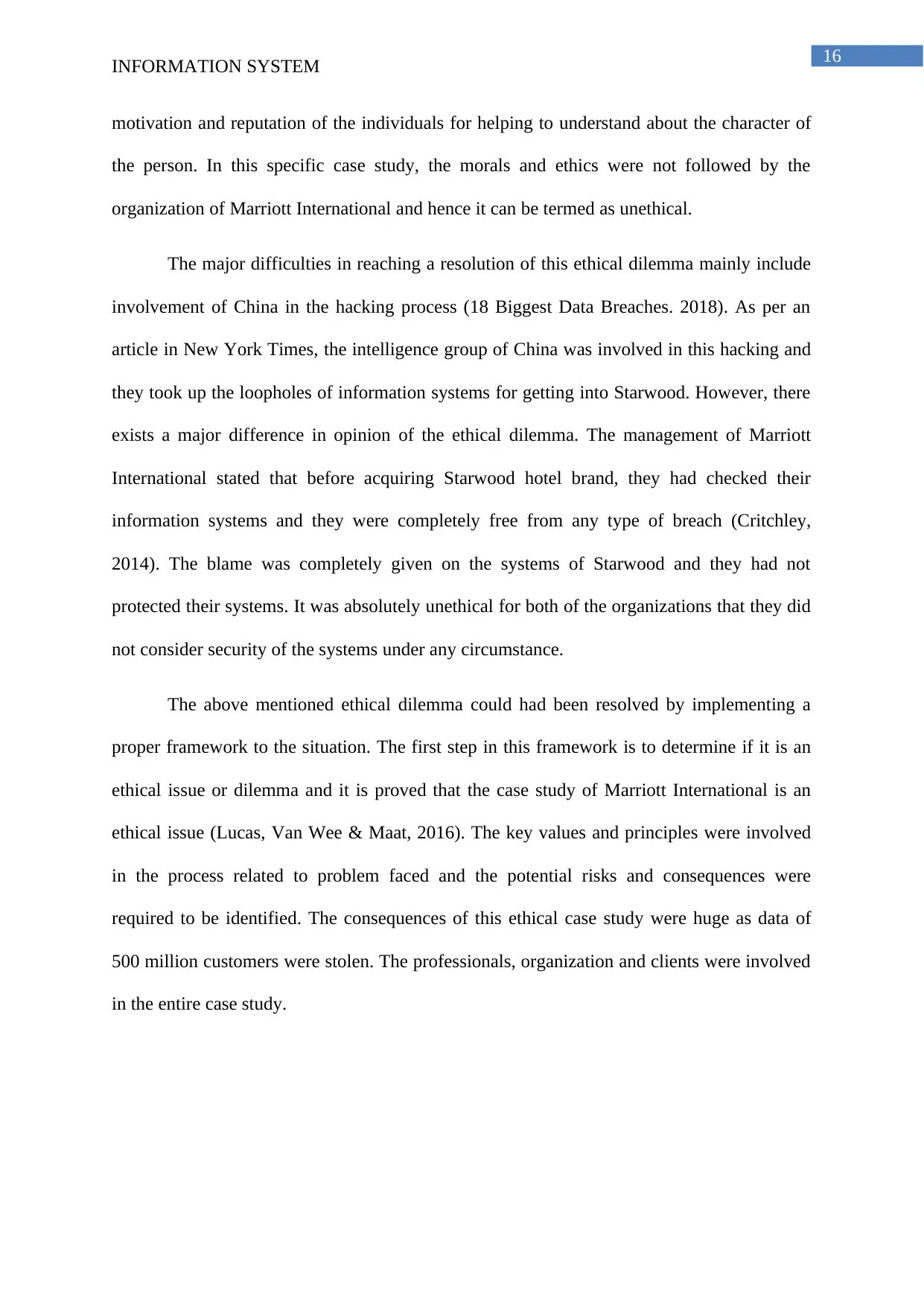
16
INFORMATION SYSTEM
motivation and reputation of the individuals for helping to understand about the character of
the person. In this specific case study, the morals and ethics were not followed by the
organization of Marriott International and hence it can be termed as unethical.
The major difficulties in reaching a resolution of this ethical dilemma mainly include
involvement of China in the hacking process (18 Biggest Data Breaches. 2018). As per an
article in New York Times, the intelligence group of China was involved in this hacking and
they took up the loopholes of information systems for getting into Starwood. However, there
exists a major difference in opinion of the ethical dilemma. The management of Marriott
International stated that before acquiring Starwood hotel brand, they had checked their
information systems and they were completely free from any type of breach (Critchley,
2014). The blame was completely given on the systems of Starwood and they had not
protected their systems. It was absolutely unethical for both of the organizations that they did
not consider security of the systems under any circumstance.
The above mentioned ethical dilemma could had been resolved by implementing a
proper framework to the situation. The first step in this framework is to determine if it is an
ethical issue or dilemma and it is proved that the case study of Marriott International is an
ethical issue (Lucas, Van Wee & Maat, 2016). The key values and principles were involved
in the process related to problem faced and the potential risks and consequences were
required to be identified. The consequences of this ethical case study were huge as data of
500 million customers were stolen. The professionals, organization and clients were involved
in the entire case study.
INFORMATION SYSTEM
motivation and reputation of the individuals for helping to understand about the character of
the person. In this specific case study, the morals and ethics were not followed by the
organization of Marriott International and hence it can be termed as unethical.
The major difficulties in reaching a resolution of this ethical dilemma mainly include
involvement of China in the hacking process (18 Biggest Data Breaches. 2018). As per an
article in New York Times, the intelligence group of China was involved in this hacking and
they took up the loopholes of information systems for getting into Starwood. However, there
exists a major difference in opinion of the ethical dilemma. The management of Marriott
International stated that before acquiring Starwood hotel brand, they had checked their
information systems and they were completely free from any type of breach (Critchley,
2014). The blame was completely given on the systems of Starwood and they had not
protected their systems. It was absolutely unethical for both of the organizations that they did
not consider security of the systems under any circumstance.
The above mentioned ethical dilemma could had been resolved by implementing a
proper framework to the situation. The first step in this framework is to determine if it is an
ethical issue or dilemma and it is proved that the case study of Marriott International is an
ethical issue (Lucas, Van Wee & Maat, 2016). The key values and principles were involved
in the process related to problem faced and the potential risks and consequences were
required to be identified. The consequences of this ethical case study were huge as data of
500 million customers were stolen. The professionals, organization and clients were involved
in the entire case study.

17
INFORMATION SYSTEM
2.5 Comparison of Two Information System Development Methods of SDLC and Agile
and Description of its Effective Uses with Examples
SDLC or software development life cycle and agile are two popular and distinctive
methodologies for developing information systems (McHugh, McCaffery & Coady, 2014).
These two are being utilized by several organizations to ensure that the information system,
made by them is providing error free and effective solutions in the business. SDLC is a type
of procedure that is being followed for systems project within an IT company. It is a
framework that can define various steps in the software development cycle. The various steps
in the framework involve planning, analysis, design, implementation and finally maintenance.
The respective process could be applied to both software and hardware components and
configuration for defining the process and scope of the project (Matharu, Mishra, Singh &
Upadhyay, 2015). SDLC helps in ensuring to deliver high quality and effective hardware and
software products to their end customers for ensuring that the high quality services and
products development is being completed efficiently for smoothly running the business.
Agile, on the other hand is a methodology that is being utilized in the entire project
management area for carrying out the entire procedure of software development life cycle
(Al-Zewairi, Biltawi, Etaiwi & Shaout, 2017). The approach of agile software development
towards the SDLC process can be executed by means of collaborative works of several cross
functional teams and even the customers. It is extremely helpful in the continuous project
deliverables, instant changes as well as in rapid developments. The comparison between
SDLC and Agile methodology is as follows:
Serial
Number
Key Features SDLC Agile
1. Definition Software development life
cycle is a procedure that is
Agile methodology is an
iterative approach, which
INFORMATION SYSTEM
2.5 Comparison of Two Information System Development Methods of SDLC and Agile
and Description of its Effective Uses with Examples
SDLC or software development life cycle and agile are two popular and distinctive
methodologies for developing information systems (McHugh, McCaffery & Coady, 2014).
These two are being utilized by several organizations to ensure that the information system,
made by them is providing error free and effective solutions in the business. SDLC is a type
of procedure that is being followed for systems project within an IT company. It is a
framework that can define various steps in the software development cycle. The various steps
in the framework involve planning, analysis, design, implementation and finally maintenance.
The respective process could be applied to both software and hardware components and
configuration for defining the process and scope of the project (Matharu, Mishra, Singh &
Upadhyay, 2015). SDLC helps in ensuring to deliver high quality and effective hardware and
software products to their end customers for ensuring that the high quality services and
products development is being completed efficiently for smoothly running the business.
Agile, on the other hand is a methodology that is being utilized in the entire project
management area for carrying out the entire procedure of software development life cycle
(Al-Zewairi, Biltawi, Etaiwi & Shaout, 2017). The approach of agile software development
towards the SDLC process can be executed by means of collaborative works of several cross
functional teams and even the customers. It is extremely helpful in the continuous project
deliverables, instant changes as well as in rapid developments. The comparison between
SDLC and Agile methodology is as follows:
Serial
Number
Key Features SDLC Agile
1. Definition Software development life
cycle is a procedure that is
Agile methodology is an
iterative approach, which

18
INFORMATION SYSTEM
being utilized for
managing any project to
run in smooth manner
(Shahane, Jamsandekar &
Shahane, 2014).
is being utilized within the
procedure of SDLC in the
software project
development.
2. Usages of the
Methodology
Software development life
cycle is being utilized for
successful creation of the
quality products in the
most effective and
efficient manner.
Agile methodology is
being utilized as the
increasing development
approach for producing
quality software products
(Popli & Chauhan, 2014).
3. Stages of the
Development
Method
Software development
lifecycle comprises of
different phases in the
entire process of
development and hence
providing various
distinctive advantages to
the users.
Agile methodology would
even comprise of various
stages in the development
model and it becomes
extremely important for
the users to execute any
step or stage at a time.
4. Platform of the
Development
Method
Software development life
cycle has the major
capability of supporting all
types of software
application development
and product development.
On the other hand, agile
methodology can support
all types of product after
splitting into several
incremental builds
(Malhotra & Chug, 2016).
INFORMATION SYSTEM
being utilized for
managing any project to
run in smooth manner
(Shahane, Jamsandekar &
Shahane, 2014).
is being utilized within the
procedure of SDLC in the
software project
development.
2. Usages of the
Methodology
Software development life
cycle is being utilized for
successful creation of the
quality products in the
most effective and
efficient manner.
Agile methodology is
being utilized as the
increasing development
approach for producing
quality software products
(Popli & Chauhan, 2014).
3. Stages of the
Development
Method
Software development
lifecycle comprises of
different phases in the
entire process of
development and hence
providing various
distinctive advantages to
the users.
Agile methodology would
even comprise of various
stages in the development
model and it becomes
extremely important for
the users to execute any
step or stage at a time.
4. Platform of the
Development
Method
Software development life
cycle has the major
capability of supporting all
types of software
application development
and product development.
On the other hand, agile
methodology can support
all types of product after
splitting into several
incremental builds
(Malhotra & Chug, 2016).
Paraphrase This Document
Need a fresh take? Get an instant paraphrase of this document with our AI Paraphraser

19
INFORMATION SYSTEM
5. Project Size One of the most important
advantages of this SDLC
include that it is suitable
for all types and sizes of
project and the results are
not erroneous for any
project (Alshamrani &
Bahattab, 2015).
Agile methodology can
only be applicable to the
smaller projects and it
does not provide proper
and accurate results in the
respective project work.
6. Changes in the
project work
Software development life
cycle eventually does not
allow any type of change
in the initial or starting
phases of the project and
hence client often does not
get any scope to change
the plan or result after
outcome (Khan & Beg,
2014).
Agile methodology on the
other hand, eventually
enables the rapid changes
during the initial phases of
the project work and
throughout the project
phase, the methodology
allows dynamic
requirements. As a result,
time consumption is
extremely high in
comparison to other
methodologies.
7. Approach Software development life
cycle comprises of
different approaches on
the basis of the
Agile methodology,
comprises of realistic
approach within the
development of the
INFORMATION SYSTEM
5. Project Size One of the most important
advantages of this SDLC
include that it is suitable
for all types and sizes of
project and the results are
not erroneous for any
project (Alshamrani &
Bahattab, 2015).
Agile methodology can
only be applicable to the
smaller projects and it
does not provide proper
and accurate results in the
respective project work.
6. Changes in the
project work
Software development life
cycle eventually does not
allow any type of change
in the initial or starting
phases of the project and
hence client often does not
get any scope to change
the plan or result after
outcome (Khan & Beg,
2014).
Agile methodology on the
other hand, eventually
enables the rapid changes
during the initial phases of
the project work and
throughout the project
phase, the methodology
allows dynamic
requirements. As a result,
time consumption is
extremely high in
comparison to other
methodologies.
7. Approach Software development life
cycle comprises of
different approaches on
the basis of the
Agile methodology,
comprises of realistic
approach within the
development of the

20
INFORMATION SYSTEM
methodology and this
particular approach is well
involved by other
companies.
project and hence
providing better scope and
opportunities to rectify
any kind of issues or
problems, highlighted by
them.
8. Management of
the Approach
The software development
life cycle is solely
dependent on the specific
methodology that is
eventually followed by the
users (Popli & Chauhan,
2014).
Agile methodology is
extremely easily to
manage in comparison to
any other methodologies
or models of information
system, development.
9. Flexibility and
Scalability
The flexibility as well as
scalability of SDLC major
is dependent on the
methodology, only when
the model is Agile or
waterfall.
Agile methodology is
highly flexible and
scalable for the developers
as well as the entire
project team (Matharu,
Mishra, Singh &
Upadhyay, 2015).
10. Different
Models
This SDLC comprises of
different models like
Waterfall, Agile,
incremental or iterative,
RAD model and spiral
Agile methodology
comprises of a set of the
best engineering standards
and practices. It even
saves money and
INFORMATION SYSTEM
methodology and this
particular approach is well
involved by other
companies.
project and hence
providing better scope and
opportunities to rectify
any kind of issues or
problems, highlighted by
them.
8. Management of
the Approach
The software development
life cycle is solely
dependent on the specific
methodology that is
eventually followed by the
users (Popli & Chauhan,
2014).
Agile methodology is
extremely easily to
manage in comparison to
any other methodologies
or models of information
system, development.
9. Flexibility and
Scalability
The flexibility as well as
scalability of SDLC major
is dependent on the
methodology, only when
the model is Agile or
waterfall.
Agile methodology is
highly flexible and
scalable for the developers
as well as the entire
project team (Matharu,
Mishra, Singh &
Upadhyay, 2015).
10. Different
Models
This SDLC comprises of
different models like
Waterfall, Agile,
incremental or iterative,
RAD model and spiral
Agile methodology
comprises of a set of the
best engineering standards
and practices. It even
saves money and

21
INFORMATION SYSTEM
models. increments predictability
after reducing failure as
well as improvising the
quality of the project that
is being delivered.
11. Design of the
Information
System
Development
Method
Software development life
cycle comprises of both
high level design or HLD
as well as low level design
or LLD that are being
utilized for analysing or
understanding the project
in both high and low level
to various kinds of team
members to clients on the
basis of technical
knowledge.
Agile model comprises of
various phases of
planning, requirements,
analyses, designing,
coding, unit testing,
testing of system
integration, non functional
testing as well as
acceptance testing
(McHugh, McCaffery &
Coady, 2014).
12. Speed of the
Methodology
Software development life
cycle eventually provides
a systematic approach to
build software for
successfully providing the
project deliverables in
timeline (Al-Zewairi,
Biltawi, Etaiwi & Shaout,
Agile methodology has
faster development
approach and even speeds
up the entire procedure of
development within the
most efficient and
effective manner.
INFORMATION SYSTEM
models. increments predictability
after reducing failure as
well as improvising the
quality of the project that
is being delivered.
11. Design of the
Information
System
Development
Method
Software development life
cycle comprises of both
high level design or HLD
as well as low level design
or LLD that are being
utilized for analysing or
understanding the project
in both high and low level
to various kinds of team
members to clients on the
basis of technical
knowledge.
Agile model comprises of
various phases of
planning, requirements,
analyses, designing,
coding, unit testing,
testing of system
integration, non functional
testing as well as
acceptance testing
(McHugh, McCaffery &
Coady, 2014).
12. Speed of the
Methodology
Software development life
cycle eventually provides
a systematic approach to
build software for
successfully providing the
project deliverables in
timeline (Al-Zewairi,
Biltawi, Etaiwi & Shaout,
Agile methodology has
faster development
approach and even speeds
up the entire procedure of
development within the
most efficient and
effective manner.
Secure Best Marks with AI Grader
Need help grading? Try our AI Grader for instant feedback on your assignments.
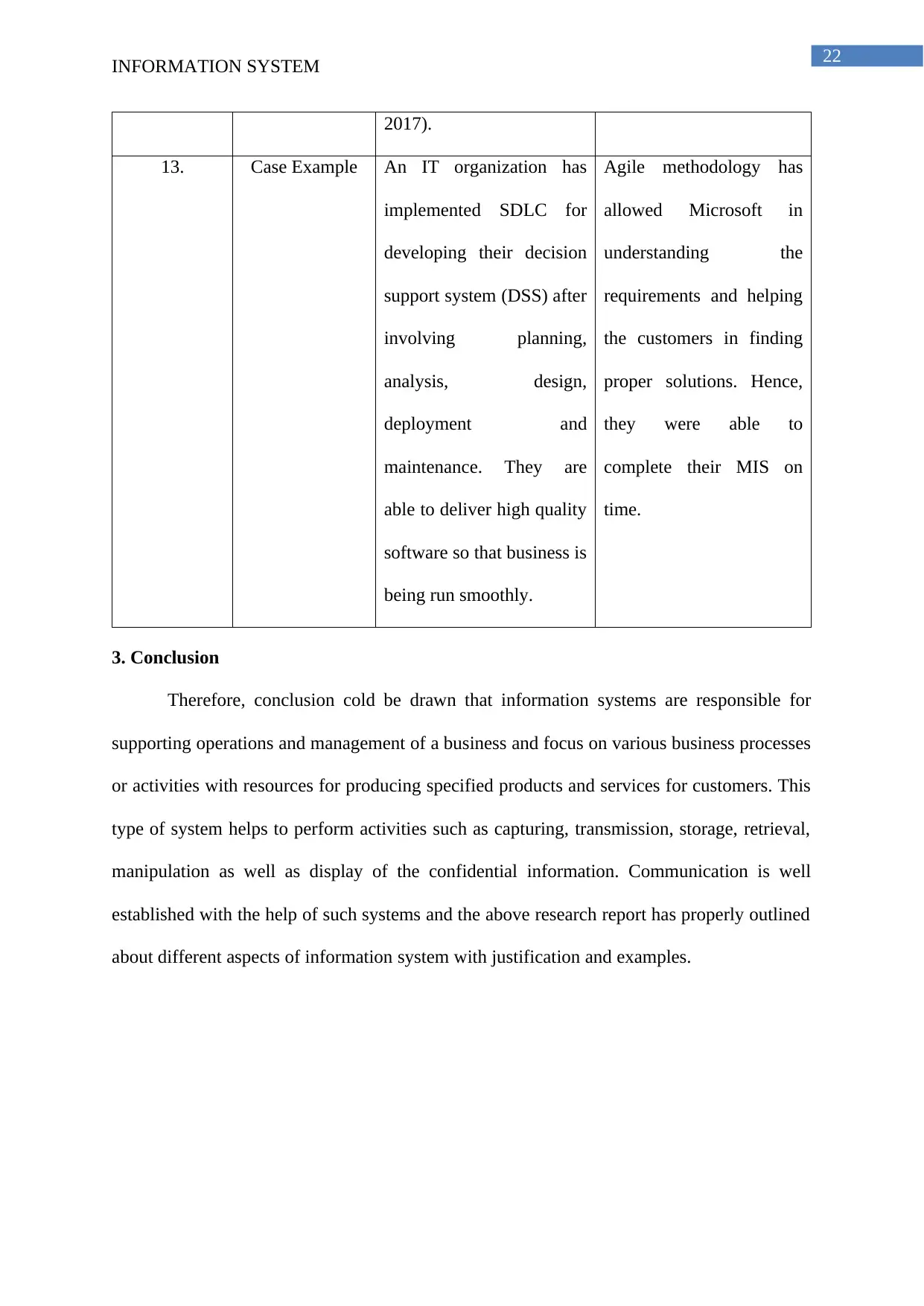
22
INFORMATION SYSTEM
2017).
13. Case Example An IT organization has
implemented SDLC for
developing their decision
support system (DSS) after
involving planning,
analysis, design,
deployment and
maintenance. They are
able to deliver high quality
software so that business is
being run smoothly.
Agile methodology has
allowed Microsoft in
understanding the
requirements and helping
the customers in finding
proper solutions. Hence,
they were able to
complete their MIS on
time.
3. Conclusion
Therefore, conclusion cold be drawn that information systems are responsible for
supporting operations and management of a business and focus on various business processes
or activities with resources for producing specified products and services for customers. This
type of system helps to perform activities such as capturing, transmission, storage, retrieval,
manipulation as well as display of the confidential information. Communication is well
established with the help of such systems and the above research report has properly outlined
about different aspects of information system with justification and examples.
INFORMATION SYSTEM
2017).
13. Case Example An IT organization has
implemented SDLC for
developing their decision
support system (DSS) after
involving planning,
analysis, design,
deployment and
maintenance. They are
able to deliver high quality
software so that business is
being run smoothly.
Agile methodology has
allowed Microsoft in
understanding the
requirements and helping
the customers in finding
proper solutions. Hence,
they were able to
complete their MIS on
time.
3. Conclusion
Therefore, conclusion cold be drawn that information systems are responsible for
supporting operations and management of a business and focus on various business processes
or activities with resources for producing specified products and services for customers. This
type of system helps to perform activities such as capturing, transmission, storage, retrieval,
manipulation as well as display of the confidential information. Communication is well
established with the help of such systems and the above research report has properly outlined
about different aspects of information system with justification and examples.

23
INFORMATION SYSTEM
References
18 Biggest Data Breaches. (2018). [online]. Accessed from
https://www.csoonline.com/article/2130877/the-biggest-data-breaches-of-the-21st-
century.html [Accessed on 21 September 2019].
Abadi, M., Agarwal, A., Barham, P., Brevdo, E., Chen, Z., Citro, C., ... & Ghemawat, S.
(2016). Tensorflow: Large-scale machine learning on heterogeneous distributed
systems. arXiv preprint arXiv:1603.04467.
Abadi, M., Barham, P., Chen, J., Chen, Z., Davis, A., Dean, J., ... & Kudlur, M. (2016).
Tensorflow: A system for large-scale machine learning. In 12th {USENIX}
Symposium on Operating Systems Design and Implementation ({OSDI} 16) (pp. 265-
283).
Al-Sakran, H. O. (2015). Intelligent traffic information system based on integration of
Internet of Things and Agent technology. International Journal of Advanced
Computer Science and Applications (IJACSA), 6(2), 37-43.
Alshamrani, A., & Bahattab, A. (2015). A comparison between three SDLC models waterfall
model, spiral model, and Incremental/Iterative model. International Journal of
Computer Science Issues (IJCSI), 12(1), 106.
Al-Zewairi, M., Biltawi, M., Etaiwi, W., & Shaout, A. (2017). Agile software development
methodologies: survey of surveys. Journal of Computer and Communications, 5(05),
74-97.
Amazon Strategies. (2018). [online]. Accessed from https://www.inc.com/marc-emmer/with-
these-7-strategies-amazon-will-dominate-any-market.html [Accessed on 21
September 2019].
INFORMATION SYSTEM
References
18 Biggest Data Breaches. (2018). [online]. Accessed from
https://www.csoonline.com/article/2130877/the-biggest-data-breaches-of-the-21st-
century.html [Accessed on 21 September 2019].
Abadi, M., Agarwal, A., Barham, P., Brevdo, E., Chen, Z., Citro, C., ... & Ghemawat, S.
(2016). Tensorflow: Large-scale machine learning on heterogeneous distributed
systems. arXiv preprint arXiv:1603.04467.
Abadi, M., Barham, P., Chen, J., Chen, Z., Davis, A., Dean, J., ... & Kudlur, M. (2016).
Tensorflow: A system for large-scale machine learning. In 12th {USENIX}
Symposium on Operating Systems Design and Implementation ({OSDI} 16) (pp. 265-
283).
Al-Sakran, H. O. (2015). Intelligent traffic information system based on integration of
Internet of Things and Agent technology. International Journal of Advanced
Computer Science and Applications (IJACSA), 6(2), 37-43.
Alshamrani, A., & Bahattab, A. (2015). A comparison between three SDLC models waterfall
model, spiral model, and Incremental/Iterative model. International Journal of
Computer Science Issues (IJCSI), 12(1), 106.
Al-Zewairi, M., Biltawi, M., Etaiwi, W., & Shaout, A. (2017). Agile software development
methodologies: survey of surveys. Journal of Computer and Communications, 5(05),
74-97.
Amazon Strategies. (2018). [online]. Accessed from https://www.inc.com/marc-emmer/with-
these-7-strategies-amazon-will-dominate-any-market.html [Accessed on 21
September 2019].
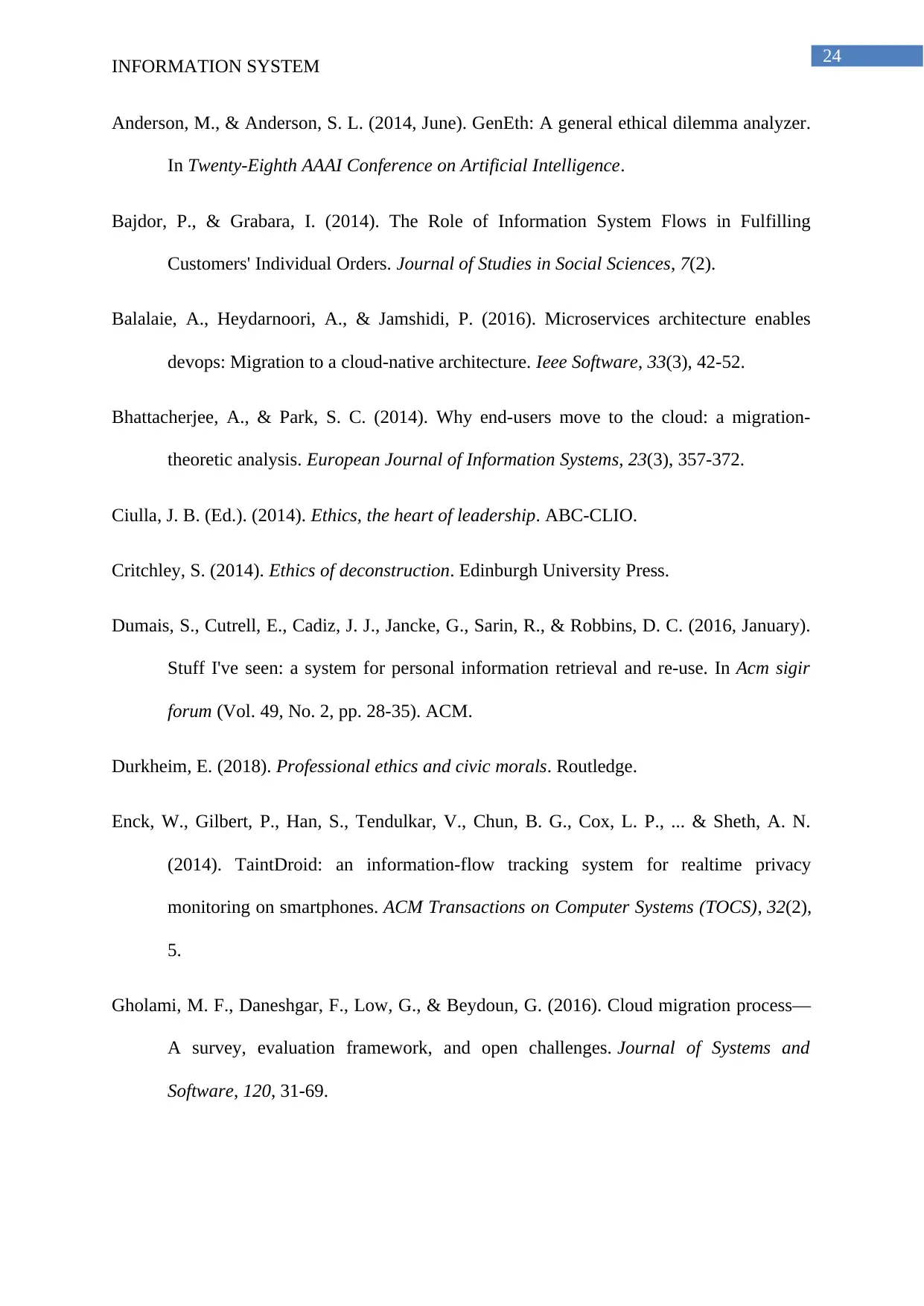
24
INFORMATION SYSTEM
Anderson, M., & Anderson, S. L. (2014, June). GenEth: A general ethical dilemma analyzer.
In Twenty-Eighth AAAI Conference on Artificial Intelligence.
Bajdor, P., & Grabara, I. (2014). The Role of Information System Flows in Fulfilling
Customers' Individual Orders. Journal of Studies in Social Sciences, 7(2).
Balalaie, A., Heydarnoori, A., & Jamshidi, P. (2016). Microservices architecture enables
devops: Migration to a cloud-native architecture. Ieee Software, 33(3), 42-52.
Bhattacherjee, A., & Park, S. C. (2014). Why end-users move to the cloud: a migration-
theoretic analysis. European Journal of Information Systems, 23(3), 357-372.
Ciulla, J. B. (Ed.). (2014). Ethics, the heart of leadership. ABC-CLIO.
Critchley, S. (2014). Ethics of deconstruction. Edinburgh University Press.
Dumais, S., Cutrell, E., Cadiz, J. J., Jancke, G., Sarin, R., & Robbins, D. C. (2016, January).
Stuff I've seen: a system for personal information retrieval and re-use. In Acm sigir
forum (Vol. 49, No. 2, pp. 28-35). ACM.
Durkheim, E. (2018). Professional ethics and civic morals. Routledge.
Enck, W., Gilbert, P., Han, S., Tendulkar, V., Chun, B. G., Cox, L. P., ... & Sheth, A. N.
(2014). TaintDroid: an information-flow tracking system for realtime privacy
monitoring on smartphones. ACM Transactions on Computer Systems (TOCS), 32(2),
5.
Gholami, M. F., Daneshgar, F., Low, G., & Beydoun, G. (2016). Cloud migration process—
A survey, evaluation framework, and open challenges. Journal of Systems and
Software, 120, 31-69.
INFORMATION SYSTEM
Anderson, M., & Anderson, S. L. (2014, June). GenEth: A general ethical dilemma analyzer.
In Twenty-Eighth AAAI Conference on Artificial Intelligence.
Bajdor, P., & Grabara, I. (2014). The Role of Information System Flows in Fulfilling
Customers' Individual Orders. Journal of Studies in Social Sciences, 7(2).
Balalaie, A., Heydarnoori, A., & Jamshidi, P. (2016). Microservices architecture enables
devops: Migration to a cloud-native architecture. Ieee Software, 33(3), 42-52.
Bhattacherjee, A., & Park, S. C. (2014). Why end-users move to the cloud: a migration-
theoretic analysis. European Journal of Information Systems, 23(3), 357-372.
Ciulla, J. B. (Ed.). (2014). Ethics, the heart of leadership. ABC-CLIO.
Critchley, S. (2014). Ethics of deconstruction. Edinburgh University Press.
Dumais, S., Cutrell, E., Cadiz, J. J., Jancke, G., Sarin, R., & Robbins, D. C. (2016, January).
Stuff I've seen: a system for personal information retrieval and re-use. In Acm sigir
forum (Vol. 49, No. 2, pp. 28-35). ACM.
Durkheim, E. (2018). Professional ethics and civic morals. Routledge.
Enck, W., Gilbert, P., Han, S., Tendulkar, V., Chun, B. G., Cox, L. P., ... & Sheth, A. N.
(2014). TaintDroid: an information-flow tracking system for realtime privacy
monitoring on smartphones. ACM Transactions on Computer Systems (TOCS), 32(2),
5.
Gholami, M. F., Daneshgar, F., Low, G., & Beydoun, G. (2016). Cloud migration process—
A survey, evaluation framework, and open challenges. Journal of Systems and
Software, 120, 31-69.
Paraphrase This Document
Need a fresh take? Get an instant paraphrase of this document with our AI Paraphraser
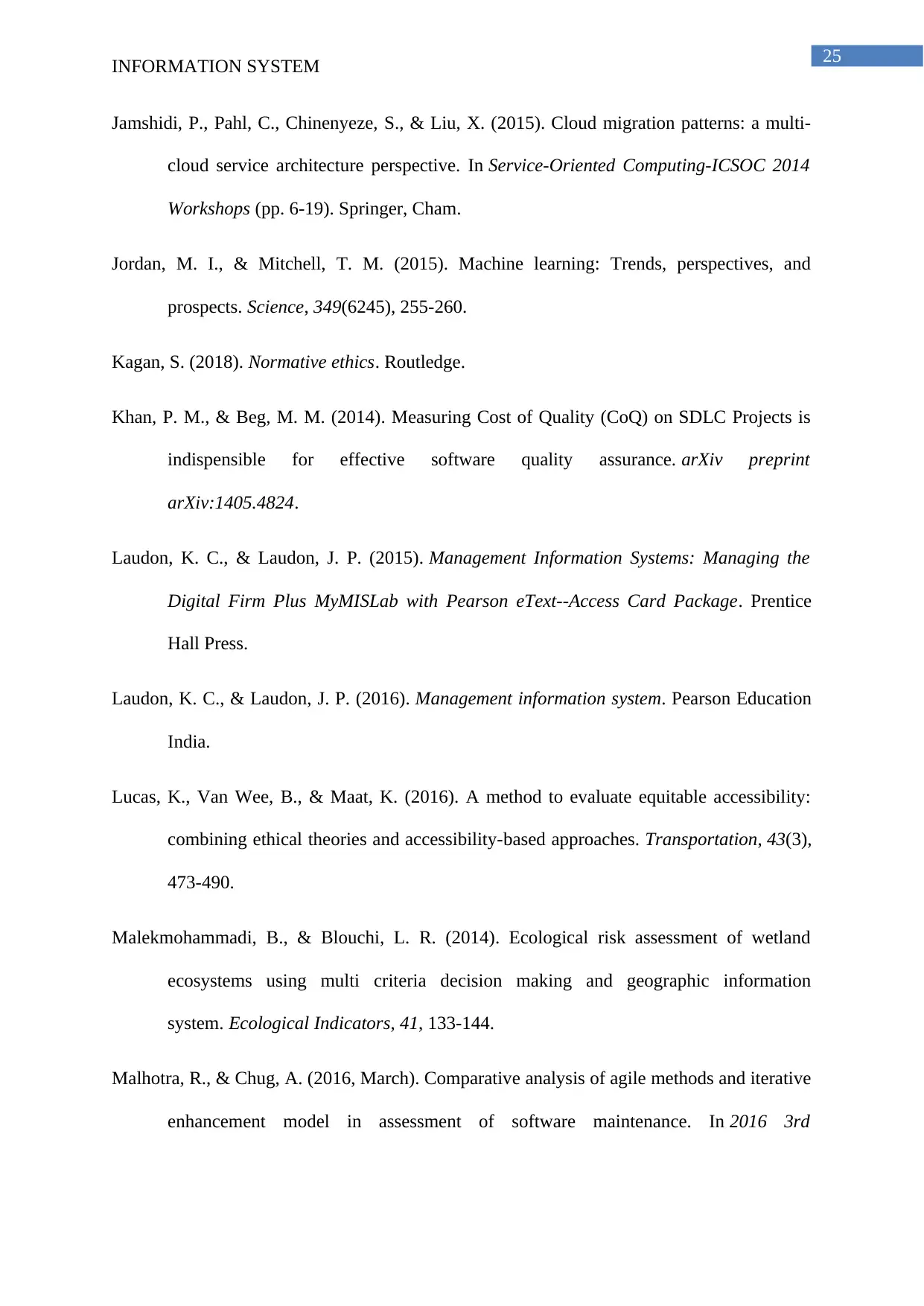
25
INFORMATION SYSTEM
Jamshidi, P., Pahl, C., Chinenyeze, S., & Liu, X. (2015). Cloud migration patterns: a multi-
cloud service architecture perspective. In Service-Oriented Computing-ICSOC 2014
Workshops (pp. 6-19). Springer, Cham.
Jordan, M. I., & Mitchell, T. M. (2015). Machine learning: Trends, perspectives, and
prospects. Science, 349(6245), 255-260.
Kagan, S. (2018). Normative ethics. Routledge.
Khan, P. M., & Beg, M. M. (2014). Measuring Cost of Quality (CoQ) on SDLC Projects is
indispensible for effective software quality assurance. arXiv preprint
arXiv:1405.4824.
Laudon, K. C., & Laudon, J. P. (2015). Management Information Systems: Managing the
Digital Firm Plus MyMISLab with Pearson eText--Access Card Package. Prentice
Hall Press.
Laudon, K. C., & Laudon, J. P. (2016). Management information system. Pearson Education
India.
Lucas, K., Van Wee, B., & Maat, K. (2016). A method to evaluate equitable accessibility:
combining ethical theories and accessibility-based approaches. Transportation, 43(3),
473-490.
Malekmohammadi, B., & Blouchi, L. R. (2014). Ecological risk assessment of wetland
ecosystems using multi criteria decision making and geographic information
system. Ecological Indicators, 41, 133-144.
Malhotra, R., & Chug, A. (2016, March). Comparative analysis of agile methods and iterative
enhancement model in assessment of software maintenance. In 2016 3rd
INFORMATION SYSTEM
Jamshidi, P., Pahl, C., Chinenyeze, S., & Liu, X. (2015). Cloud migration patterns: a multi-
cloud service architecture perspective. In Service-Oriented Computing-ICSOC 2014
Workshops (pp. 6-19). Springer, Cham.
Jordan, M. I., & Mitchell, T. M. (2015). Machine learning: Trends, perspectives, and
prospects. Science, 349(6245), 255-260.
Kagan, S. (2018). Normative ethics. Routledge.
Khan, P. M., & Beg, M. M. (2014). Measuring Cost of Quality (CoQ) on SDLC Projects is
indispensible for effective software quality assurance. arXiv preprint
arXiv:1405.4824.
Laudon, K. C., & Laudon, J. P. (2015). Management Information Systems: Managing the
Digital Firm Plus MyMISLab with Pearson eText--Access Card Package. Prentice
Hall Press.
Laudon, K. C., & Laudon, J. P. (2016). Management information system. Pearson Education
India.
Lucas, K., Van Wee, B., & Maat, K. (2016). A method to evaluate equitable accessibility:
combining ethical theories and accessibility-based approaches. Transportation, 43(3),
473-490.
Malekmohammadi, B., & Blouchi, L. R. (2014). Ecological risk assessment of wetland
ecosystems using multi criteria decision making and geographic information
system. Ecological Indicators, 41, 133-144.
Malhotra, R., & Chug, A. (2016, March). Comparative analysis of agile methods and iterative
enhancement model in assessment of software maintenance. In 2016 3rd
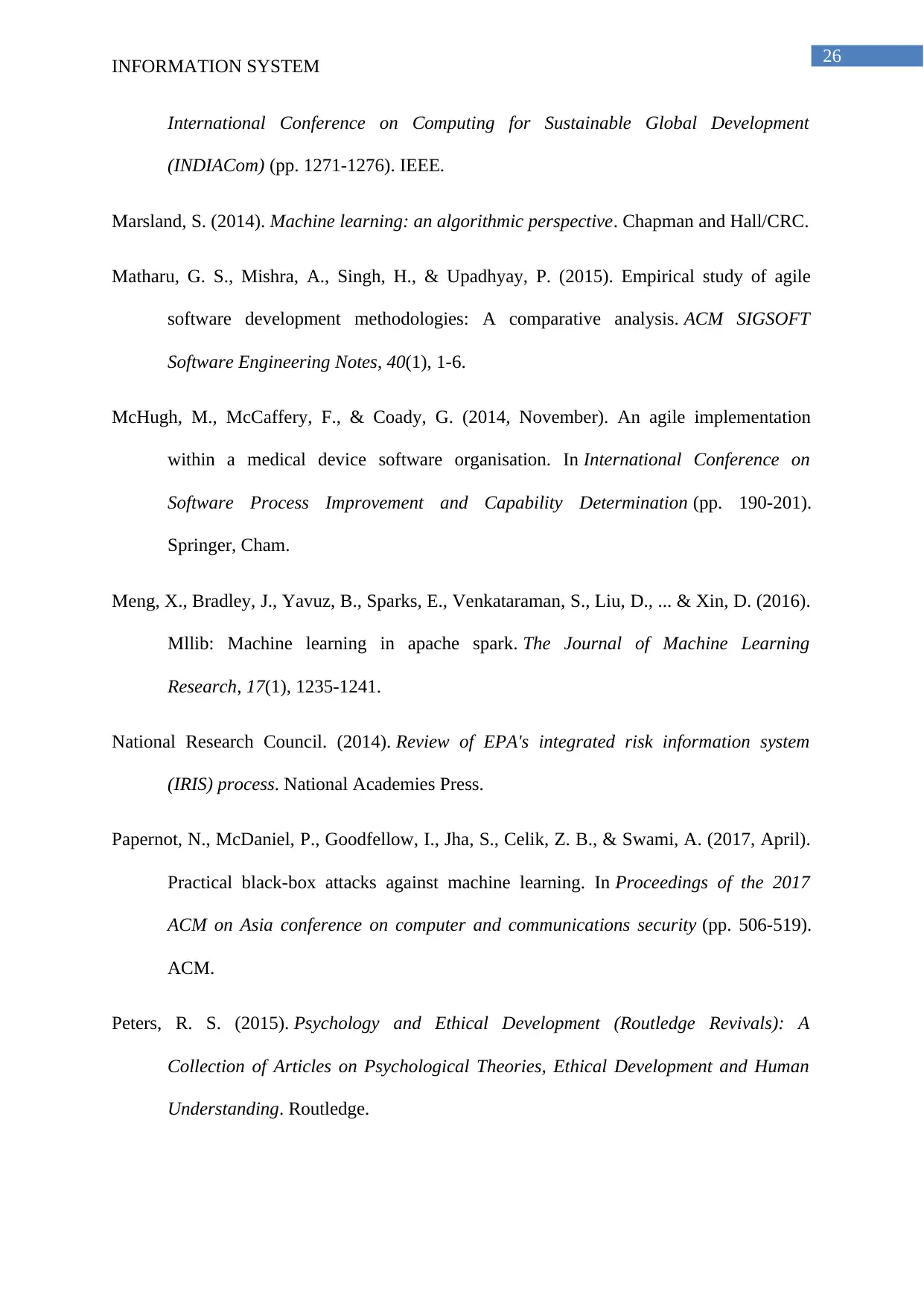
26
INFORMATION SYSTEM
International Conference on Computing for Sustainable Global Development
(INDIACom) (pp. 1271-1276). IEEE.
Marsland, S. (2014). Machine learning: an algorithmic perspective. Chapman and Hall/CRC.
Matharu, G. S., Mishra, A., Singh, H., & Upadhyay, P. (2015). Empirical study of agile
software development methodologies: A comparative analysis. ACM SIGSOFT
Software Engineering Notes, 40(1), 1-6.
McHugh, M., McCaffery, F., & Coady, G. (2014, November). An agile implementation
within a medical device software organisation. In International Conference on
Software Process Improvement and Capability Determination (pp. 190-201).
Springer, Cham.
Meng, X., Bradley, J., Yavuz, B., Sparks, E., Venkataraman, S., Liu, D., ... & Xin, D. (2016).
Mllib: Machine learning in apache spark. The Journal of Machine Learning
Research, 17(1), 1235-1241.
National Research Council. (2014). Review of EPA's integrated risk information system
(IRIS) process. National Academies Press.
Papernot, N., McDaniel, P., Goodfellow, I., Jha, S., Celik, Z. B., & Swami, A. (2017, April).
Practical black-box attacks against machine learning. In Proceedings of the 2017
ACM on Asia conference on computer and communications security (pp. 506-519).
ACM.
Peters, R. S. (2015). Psychology and Ethical Development (Routledge Revivals): A
Collection of Articles on Psychological Theories, Ethical Development and Human
Understanding. Routledge.
INFORMATION SYSTEM
International Conference on Computing for Sustainable Global Development
(INDIACom) (pp. 1271-1276). IEEE.
Marsland, S. (2014). Machine learning: an algorithmic perspective. Chapman and Hall/CRC.
Matharu, G. S., Mishra, A., Singh, H., & Upadhyay, P. (2015). Empirical study of agile
software development methodologies: A comparative analysis. ACM SIGSOFT
Software Engineering Notes, 40(1), 1-6.
McHugh, M., McCaffery, F., & Coady, G. (2014, November). An agile implementation
within a medical device software organisation. In International Conference on
Software Process Improvement and Capability Determination (pp. 190-201).
Springer, Cham.
Meng, X., Bradley, J., Yavuz, B., Sparks, E., Venkataraman, S., Liu, D., ... & Xin, D. (2016).
Mllib: Machine learning in apache spark. The Journal of Machine Learning
Research, 17(1), 1235-1241.
National Research Council. (2014). Review of EPA's integrated risk information system
(IRIS) process. National Academies Press.
Papernot, N., McDaniel, P., Goodfellow, I., Jha, S., Celik, Z. B., & Swami, A. (2017, April).
Practical black-box attacks against machine learning. In Proceedings of the 2017
ACM on Asia conference on computer and communications security (pp. 506-519).
ACM.
Peters, R. S. (2015). Psychology and Ethical Development (Routledge Revivals): A
Collection of Articles on Psychological Theories, Ethical Development and Human
Understanding. Routledge.
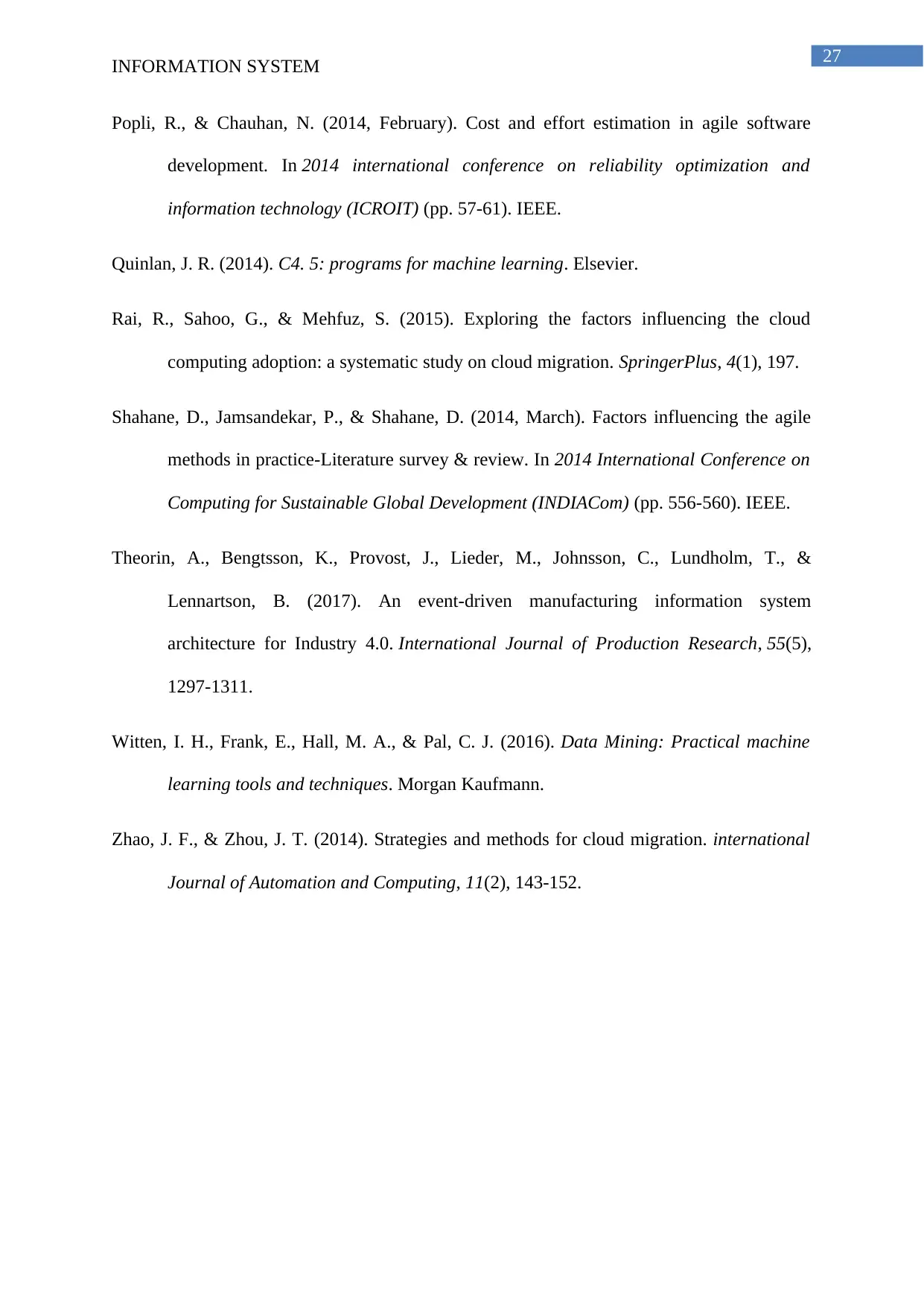
27
INFORMATION SYSTEM
Popli, R., & Chauhan, N. (2014, February). Cost and effort estimation in agile software
development. In 2014 international conference on reliability optimization and
information technology (ICROIT) (pp. 57-61). IEEE.
Quinlan, J. R. (2014). C4. 5: programs for machine learning. Elsevier.
Rai, R., Sahoo, G., & Mehfuz, S. (2015). Exploring the factors influencing the cloud
computing adoption: a systematic study on cloud migration. SpringerPlus, 4(1), 197.
Shahane, D., Jamsandekar, P., & Shahane, D. (2014, March). Factors influencing the agile
methods in practice-Literature survey & review. In 2014 International Conference on
Computing for Sustainable Global Development (INDIACom) (pp. 556-560). IEEE.
Theorin, A., Bengtsson, K., Provost, J., Lieder, M., Johnsson, C., Lundholm, T., &
Lennartson, B. (2017). An event-driven manufacturing information system
architecture for Industry 4.0. International Journal of Production Research, 55(5),
1297-1311.
Witten, I. H., Frank, E., Hall, M. A., & Pal, C. J. (2016). Data Mining: Practical machine
learning tools and techniques. Morgan Kaufmann.
Zhao, J. F., & Zhou, J. T. (2014). Strategies and methods for cloud migration. international
Journal of Automation and Computing, 11(2), 143-152.
INFORMATION SYSTEM
Popli, R., & Chauhan, N. (2014, February). Cost and effort estimation in agile software
development. In 2014 international conference on reliability optimization and
information technology (ICROIT) (pp. 57-61). IEEE.
Quinlan, J. R. (2014). C4. 5: programs for machine learning. Elsevier.
Rai, R., Sahoo, G., & Mehfuz, S. (2015). Exploring the factors influencing the cloud
computing adoption: a systematic study on cloud migration. SpringerPlus, 4(1), 197.
Shahane, D., Jamsandekar, P., & Shahane, D. (2014, March). Factors influencing the agile
methods in practice-Literature survey & review. In 2014 International Conference on
Computing for Sustainable Global Development (INDIACom) (pp. 556-560). IEEE.
Theorin, A., Bengtsson, K., Provost, J., Lieder, M., Johnsson, C., Lundholm, T., &
Lennartson, B. (2017). An event-driven manufacturing information system
architecture for Industry 4.0. International Journal of Production Research, 55(5),
1297-1311.
Witten, I. H., Frank, E., Hall, M. A., & Pal, C. J. (2016). Data Mining: Practical machine
learning tools and techniques. Morgan Kaufmann.
Zhao, J. F., & Zhou, J. T. (2014). Strategies and methods for cloud migration. international
Journal of Automation and Computing, 11(2), 143-152.
1 out of 28
Related Documents
Your All-in-One AI-Powered Toolkit for Academic Success.
+13062052269
info@desklib.com
Available 24*7 on WhatsApp / Email
![[object Object]](/_next/static/media/star-bottom.7253800d.svg)
Unlock your academic potential
© 2024 | Zucol Services PVT LTD | All rights reserved.




